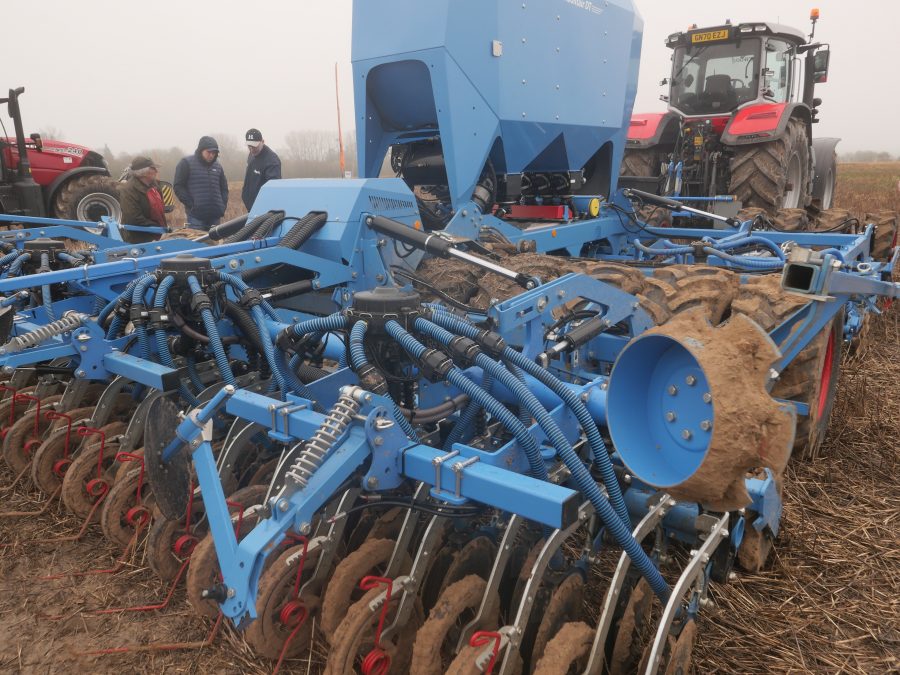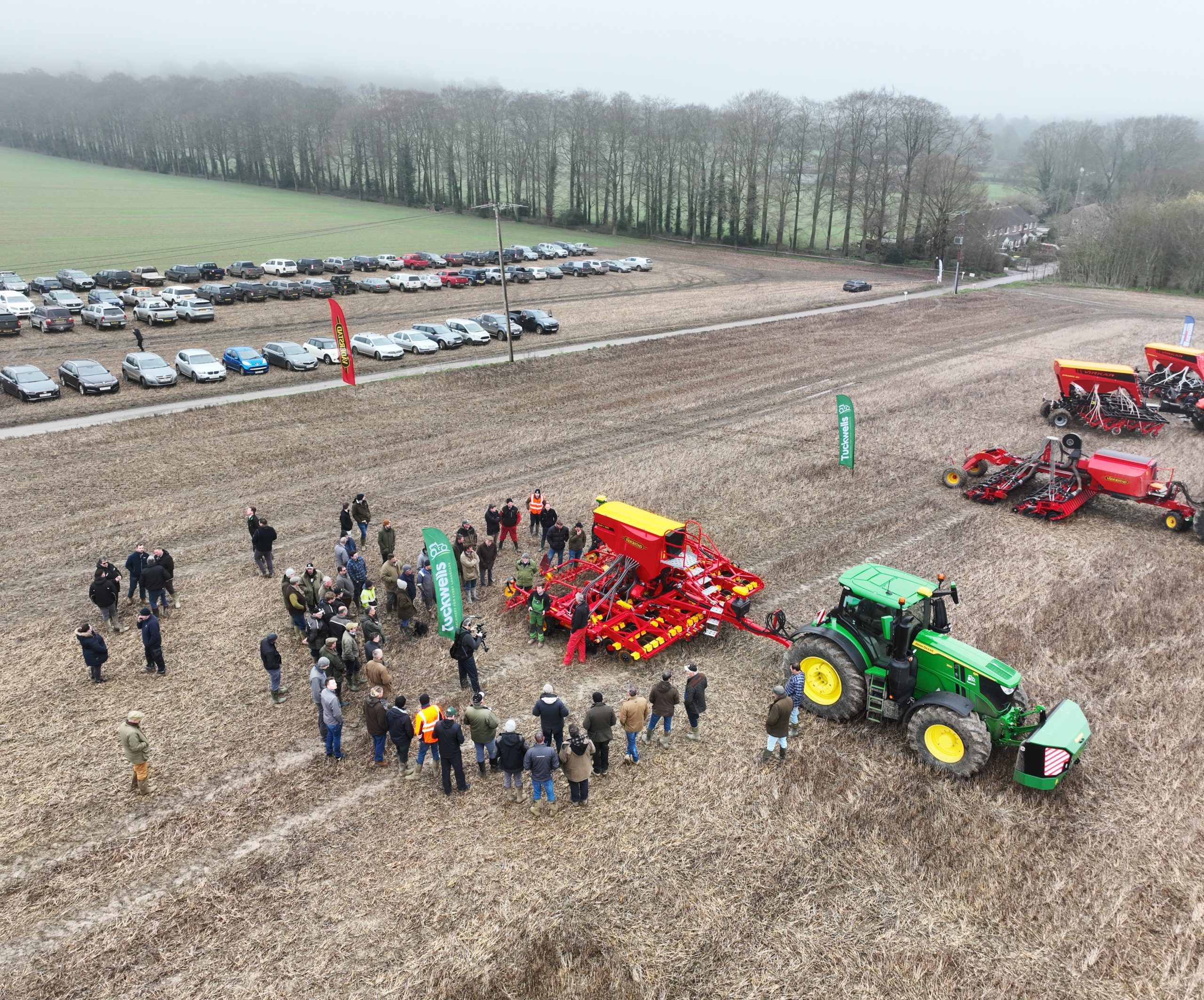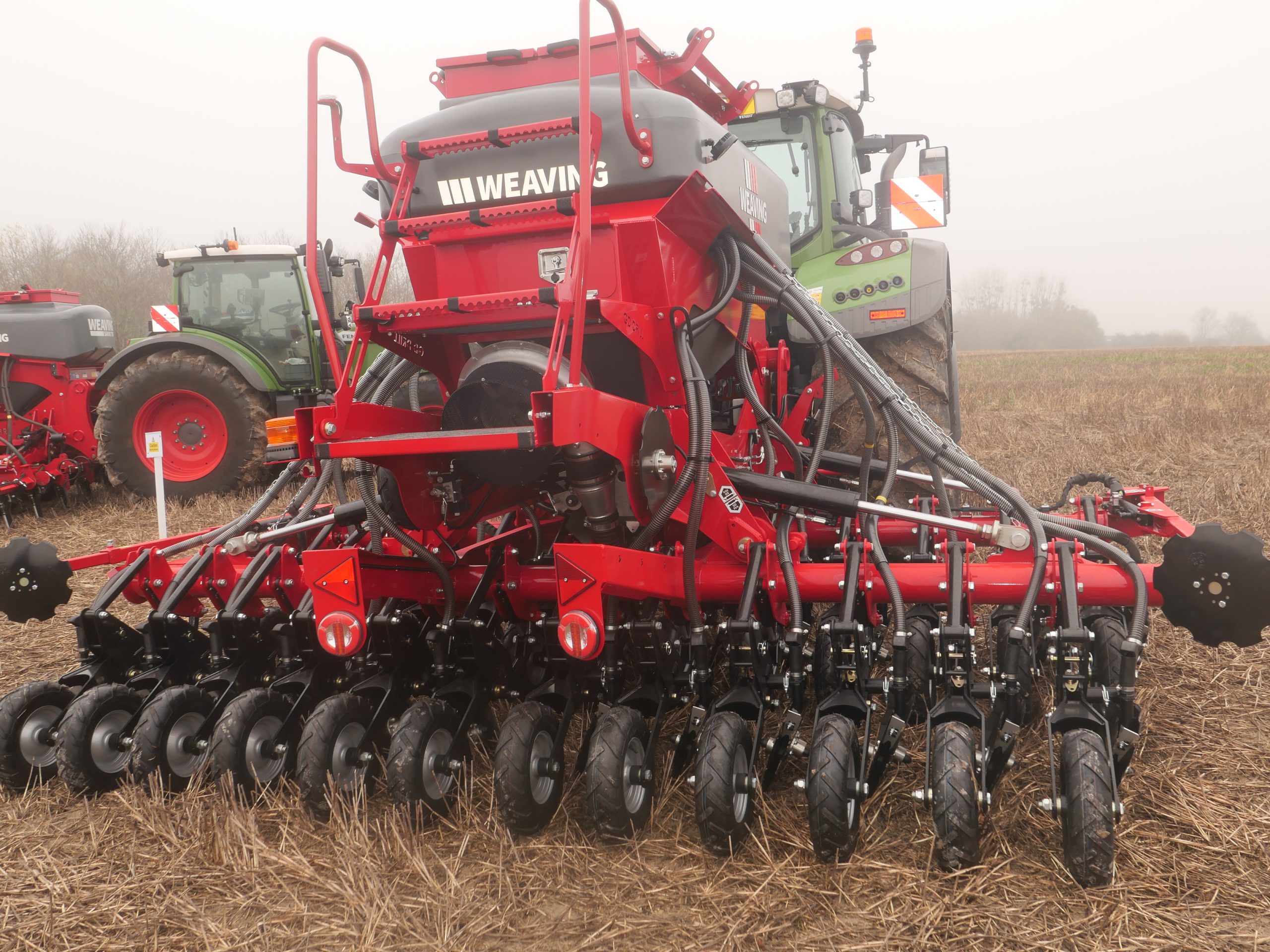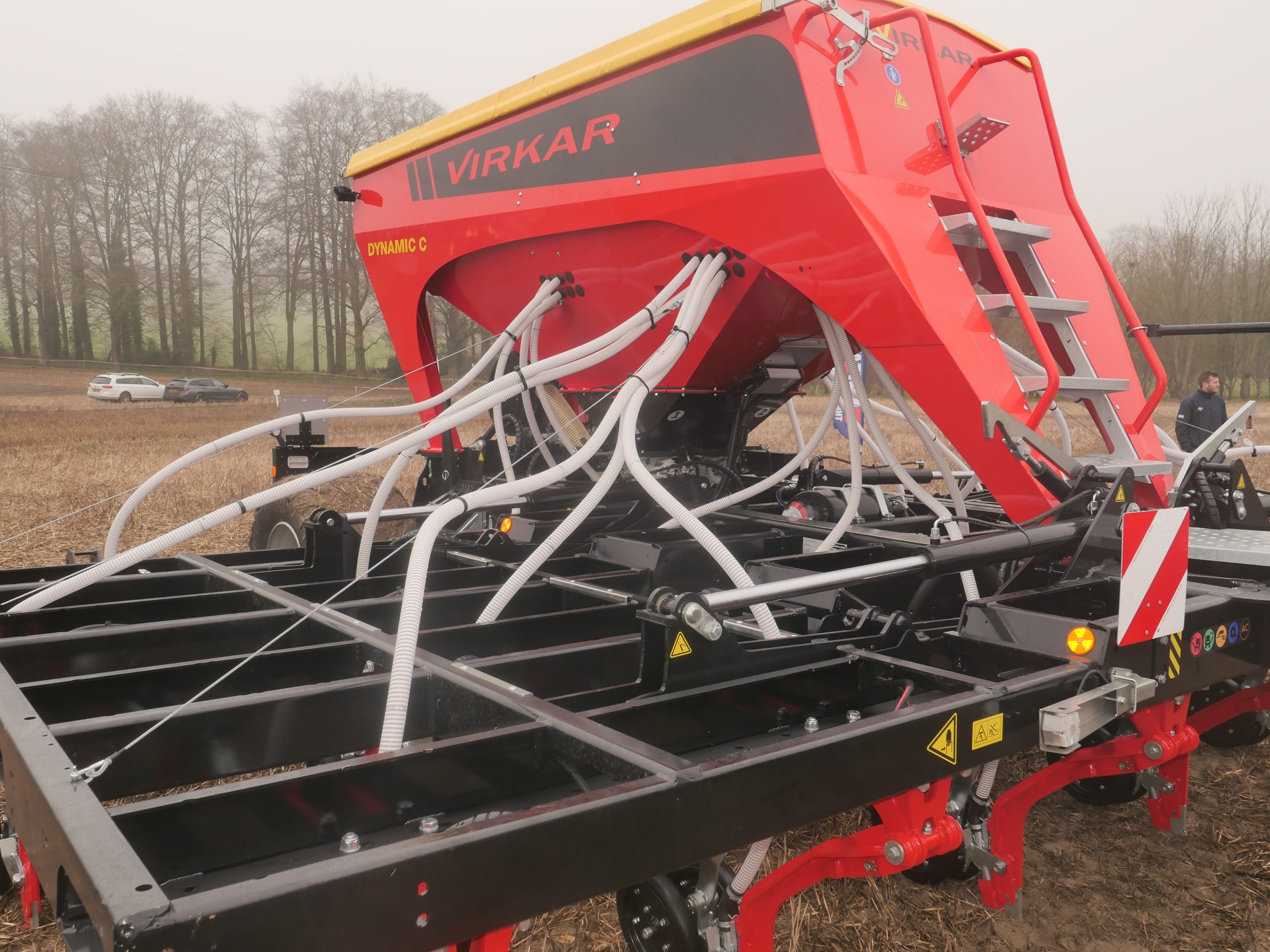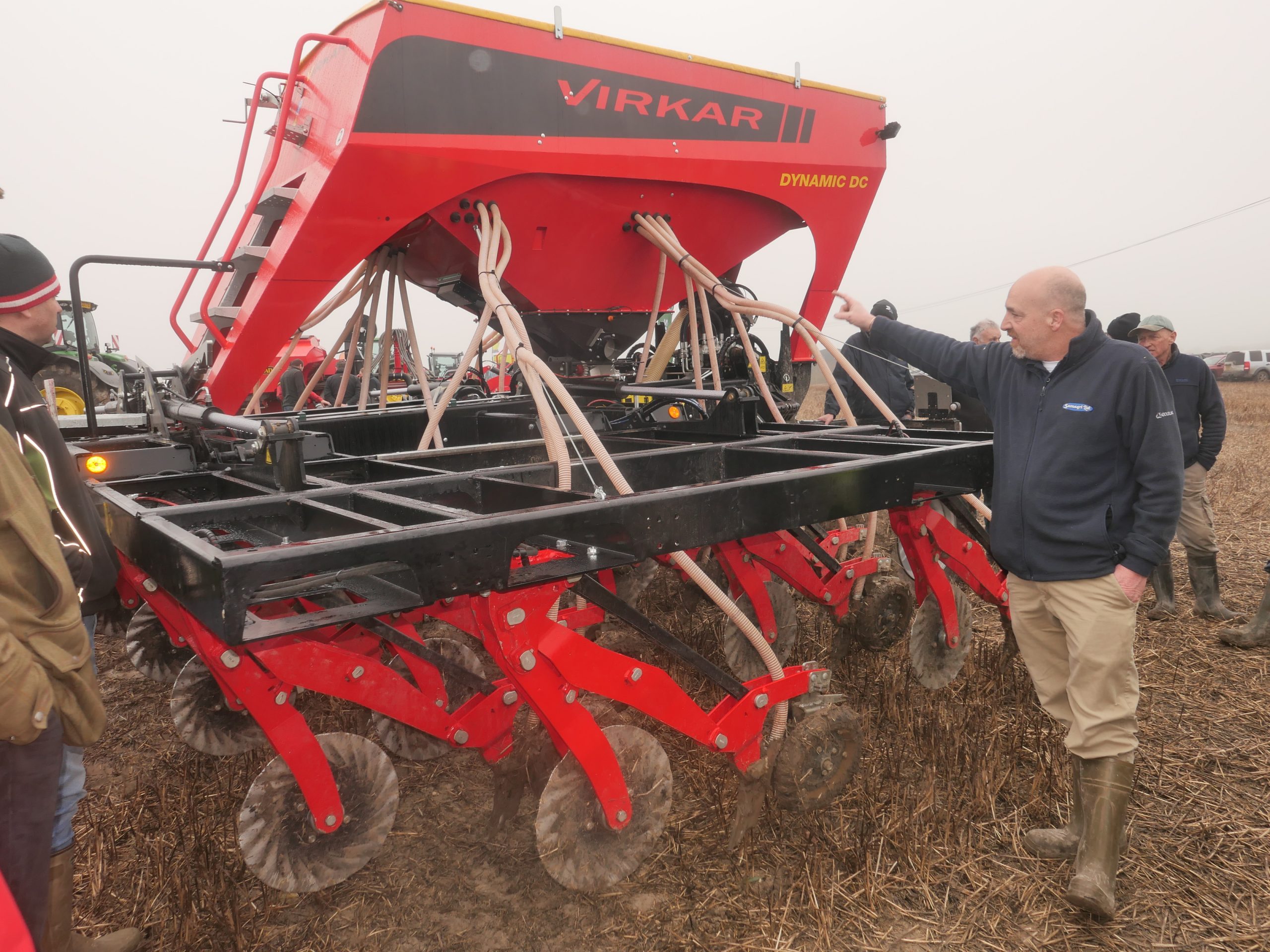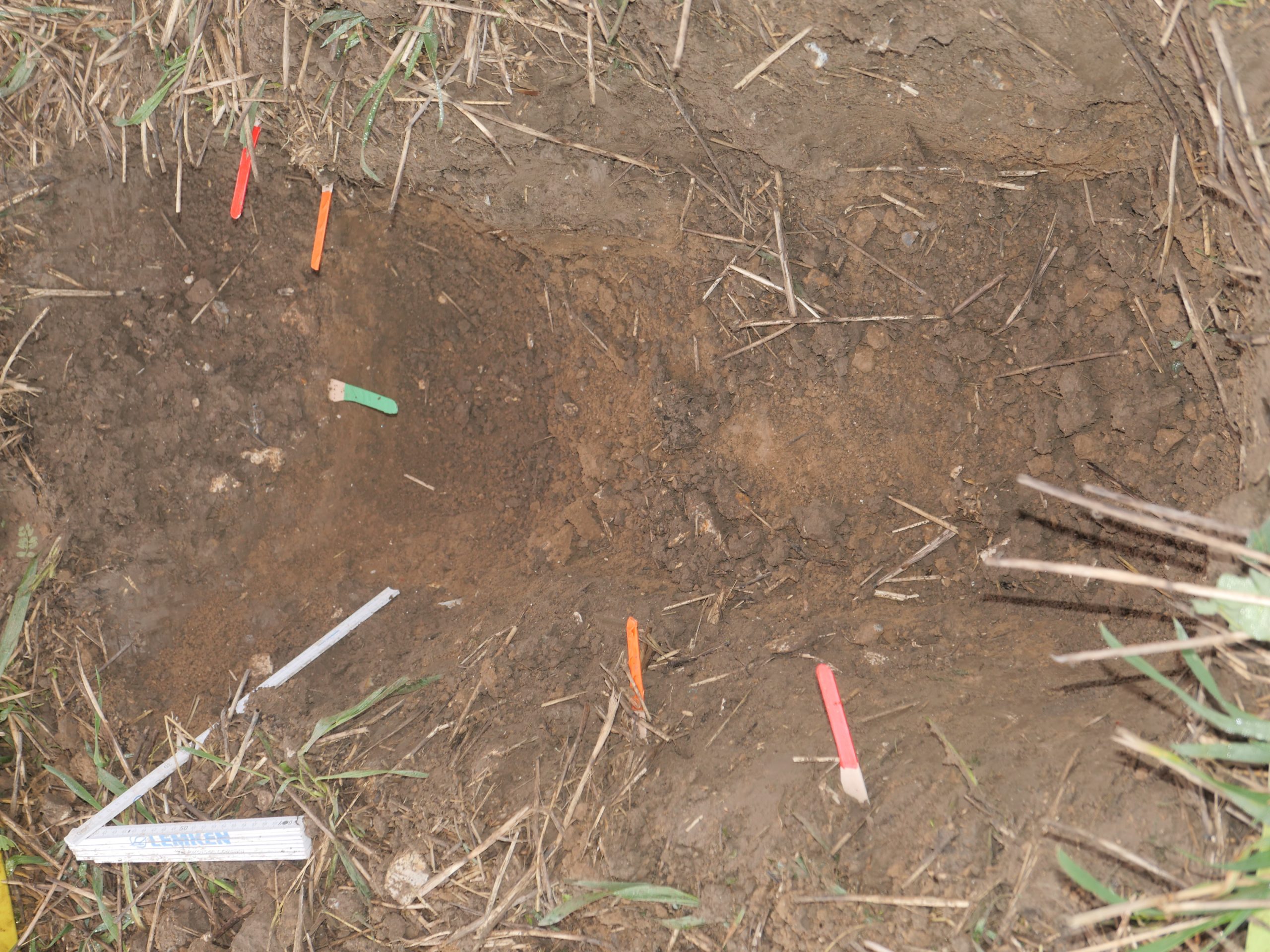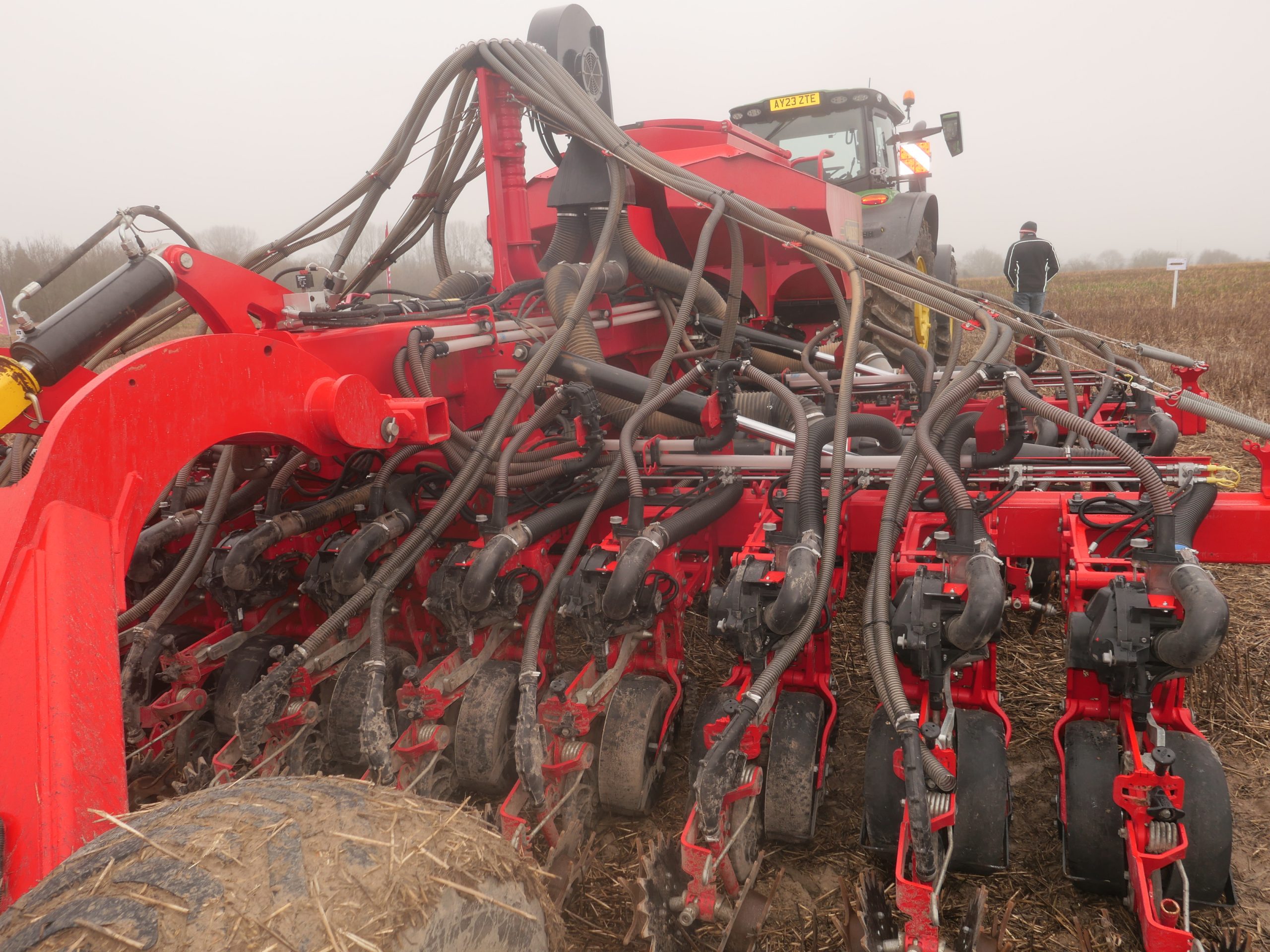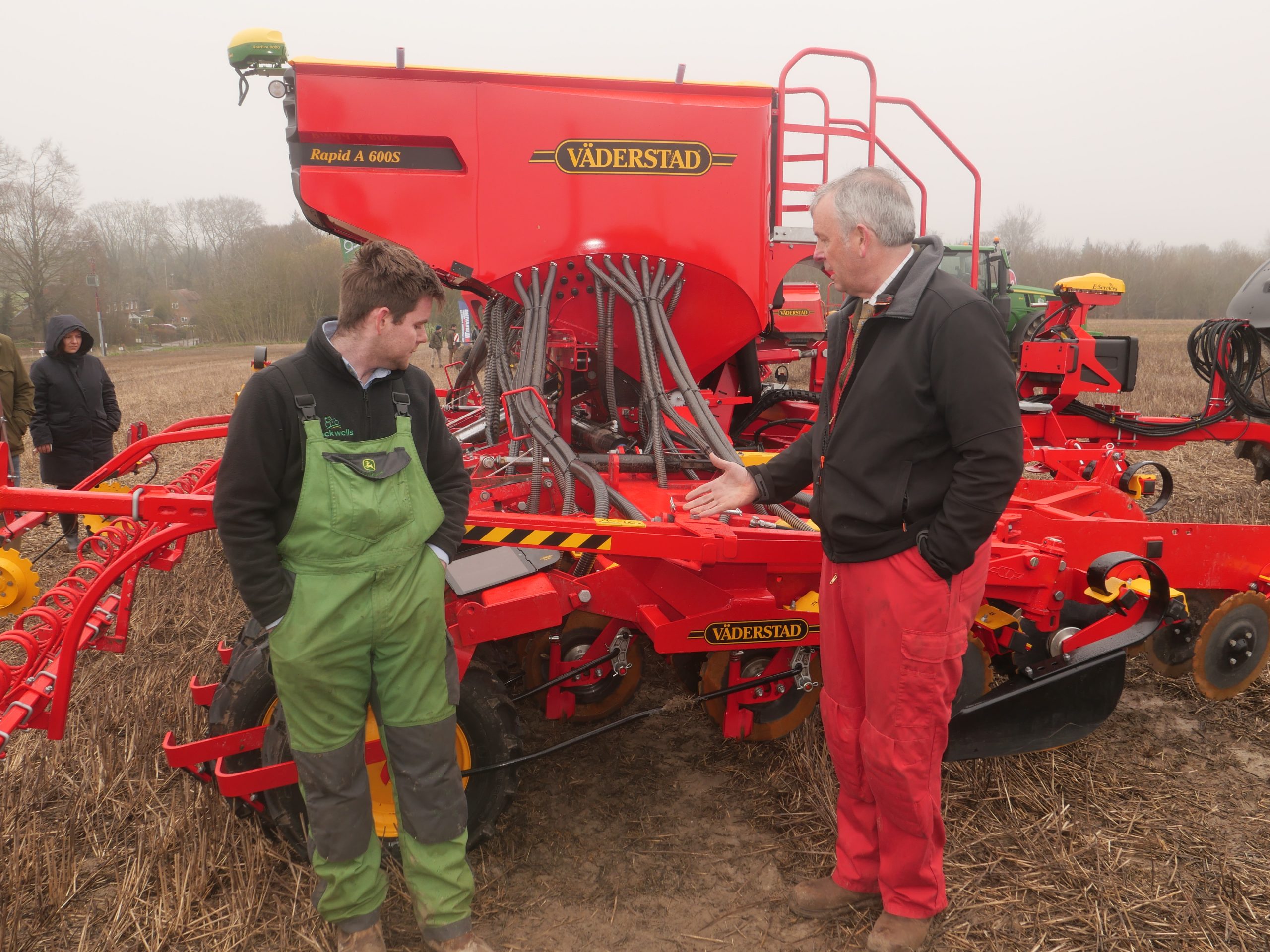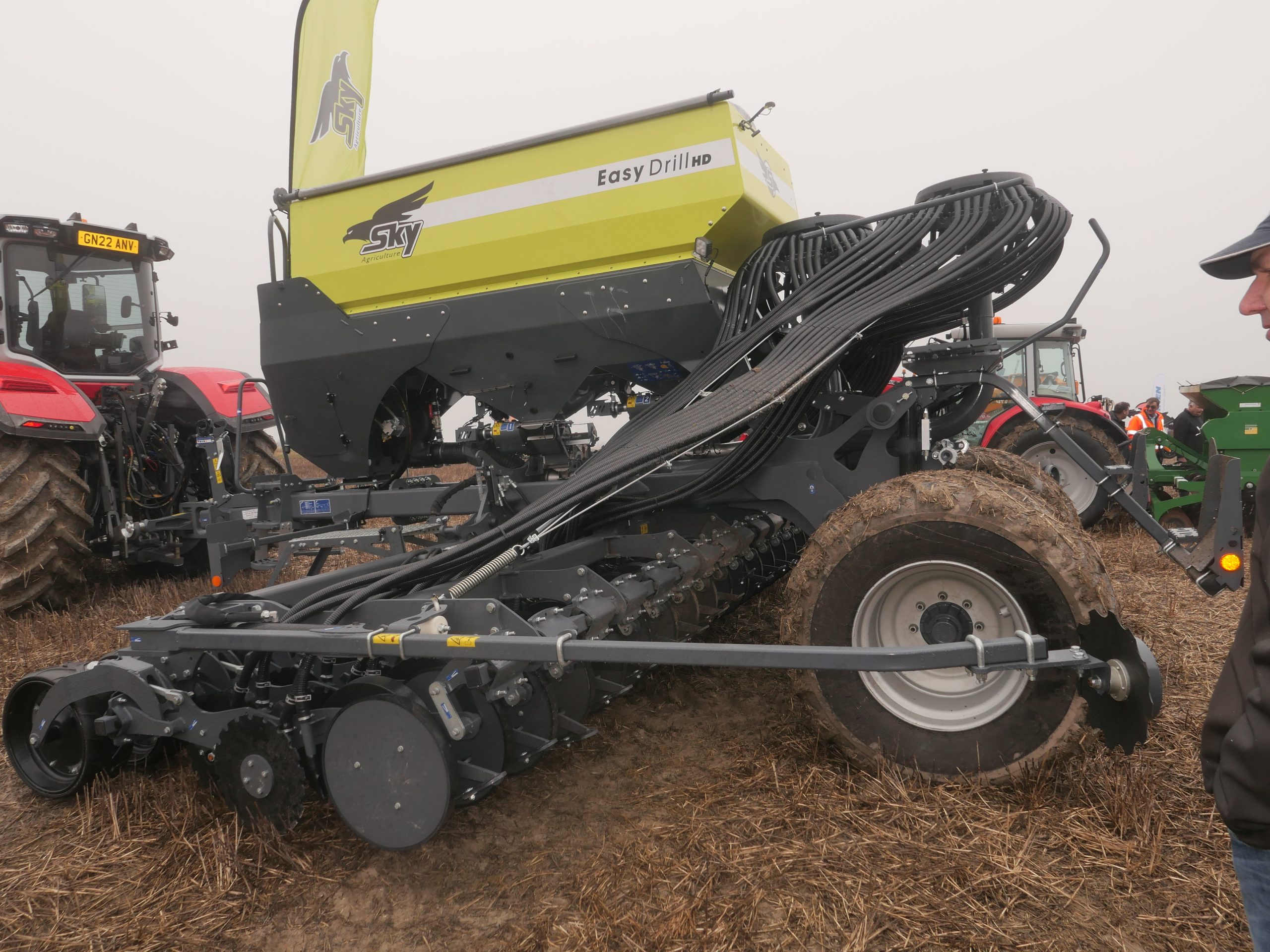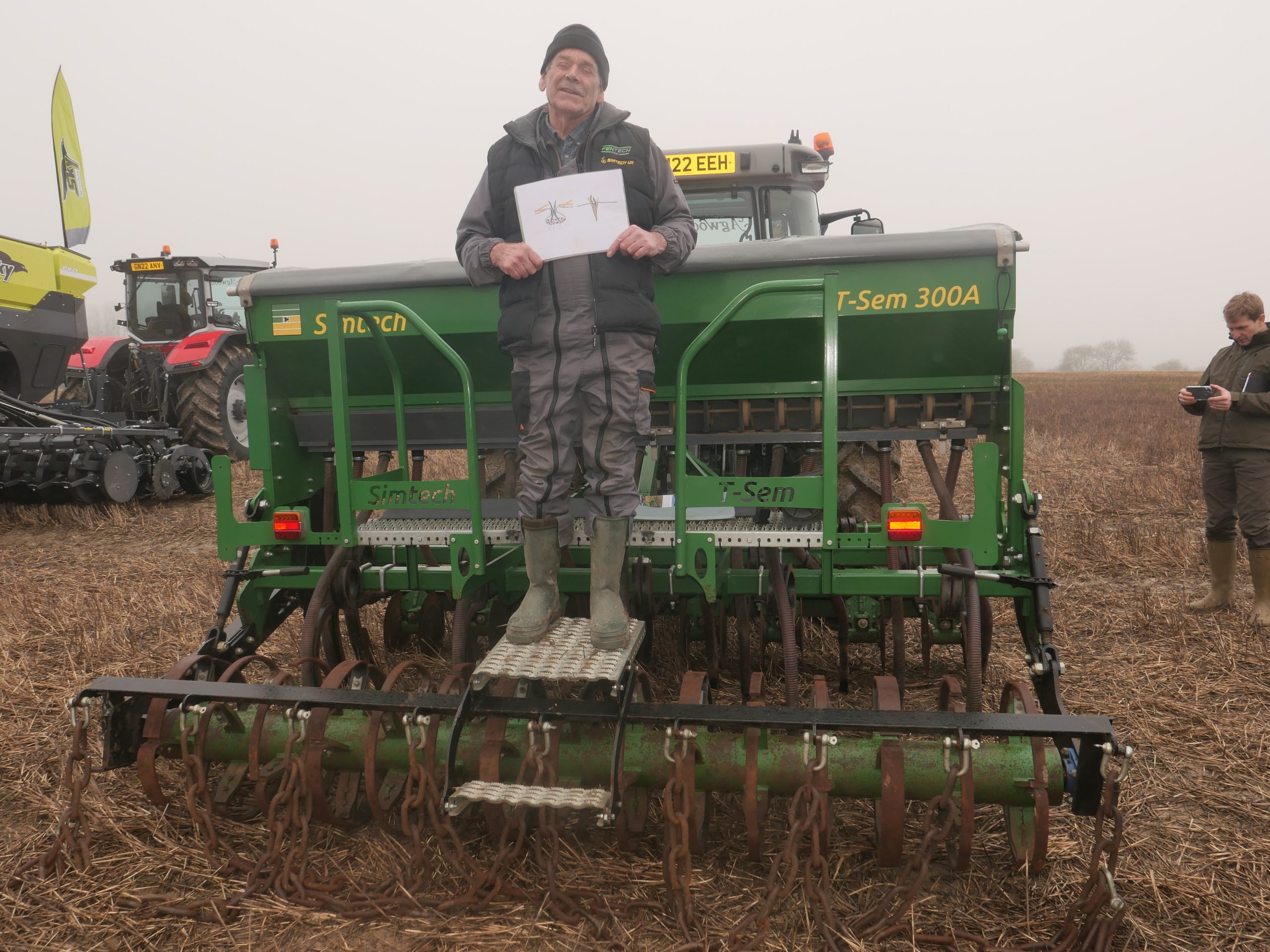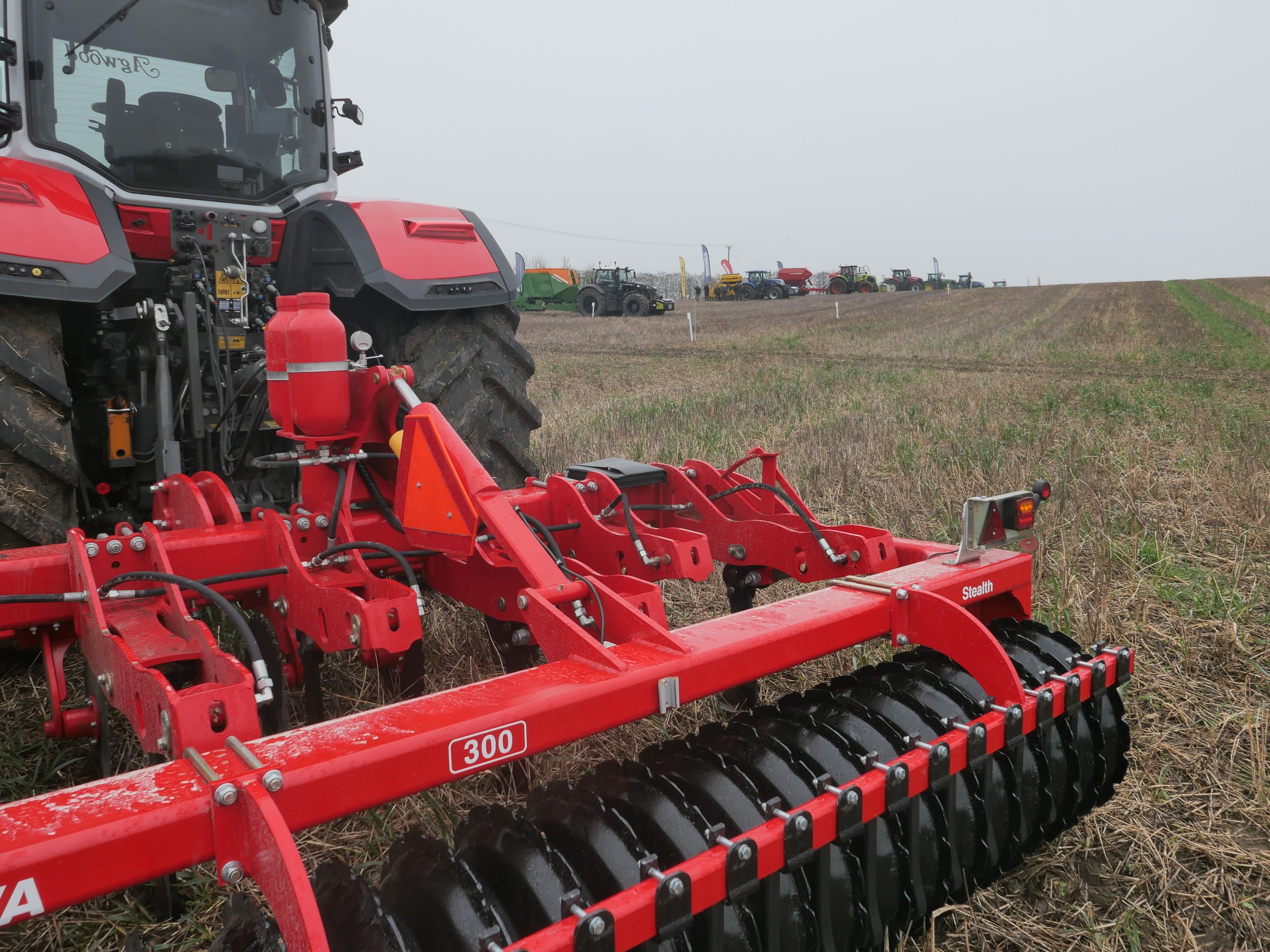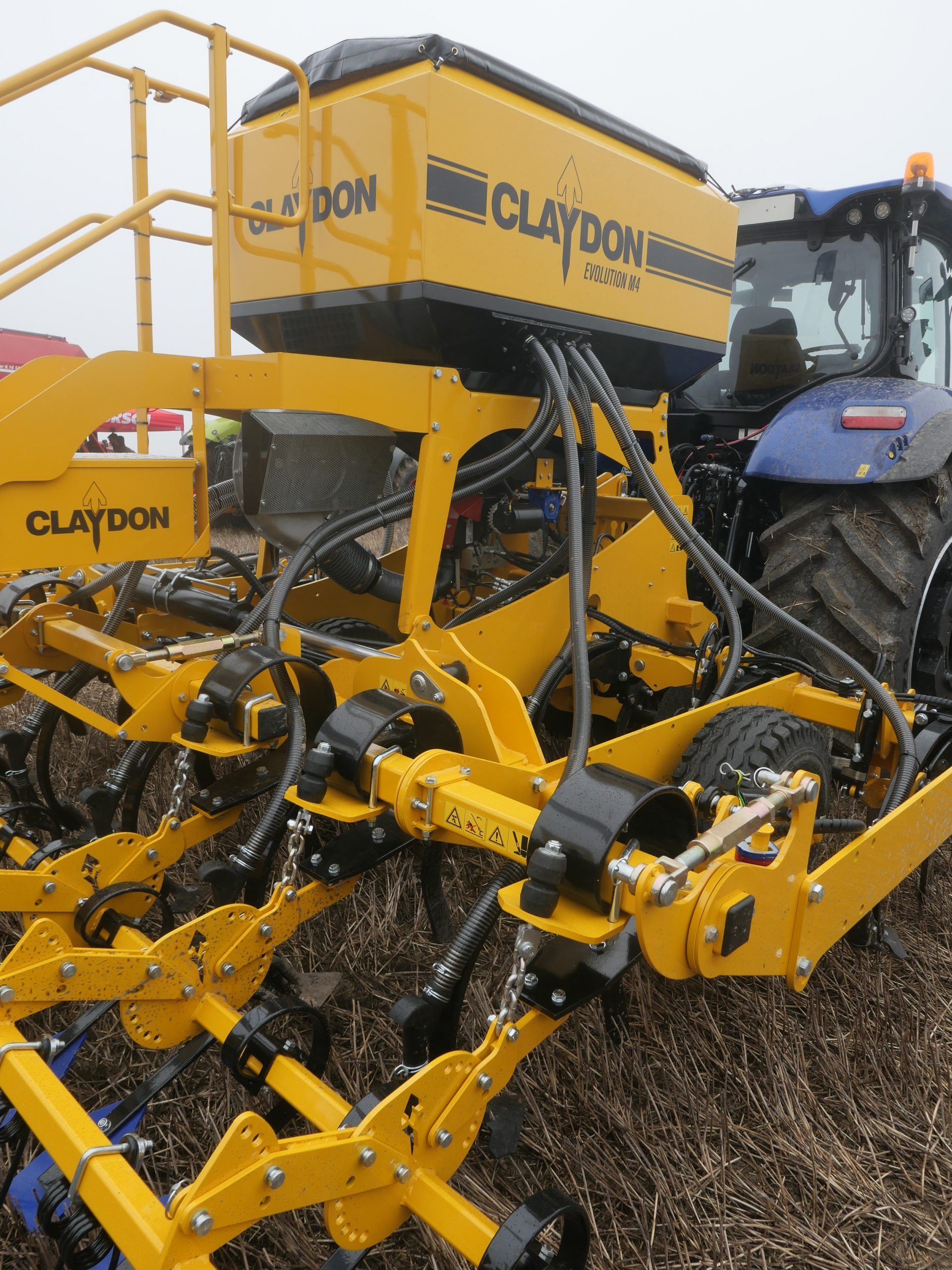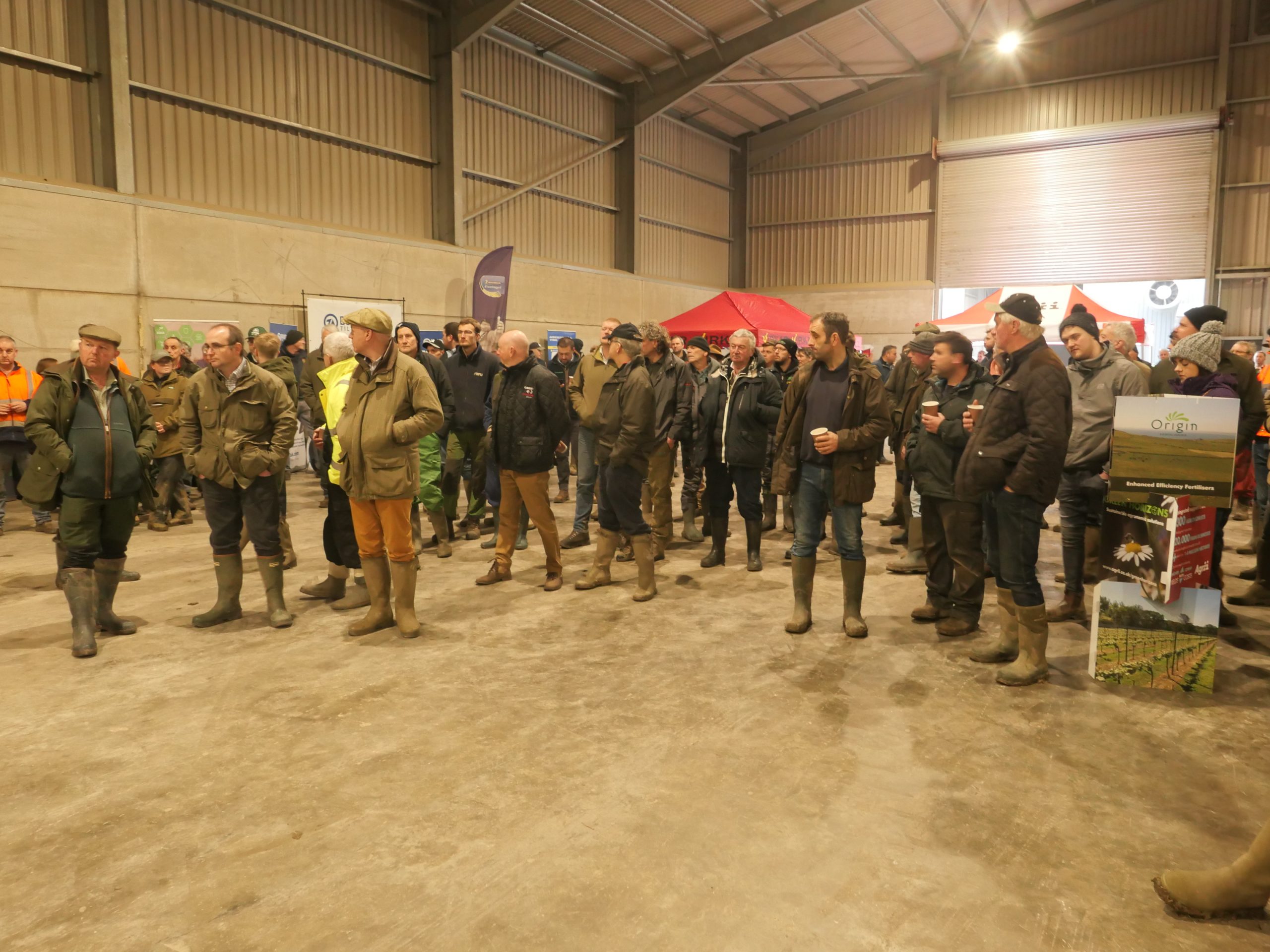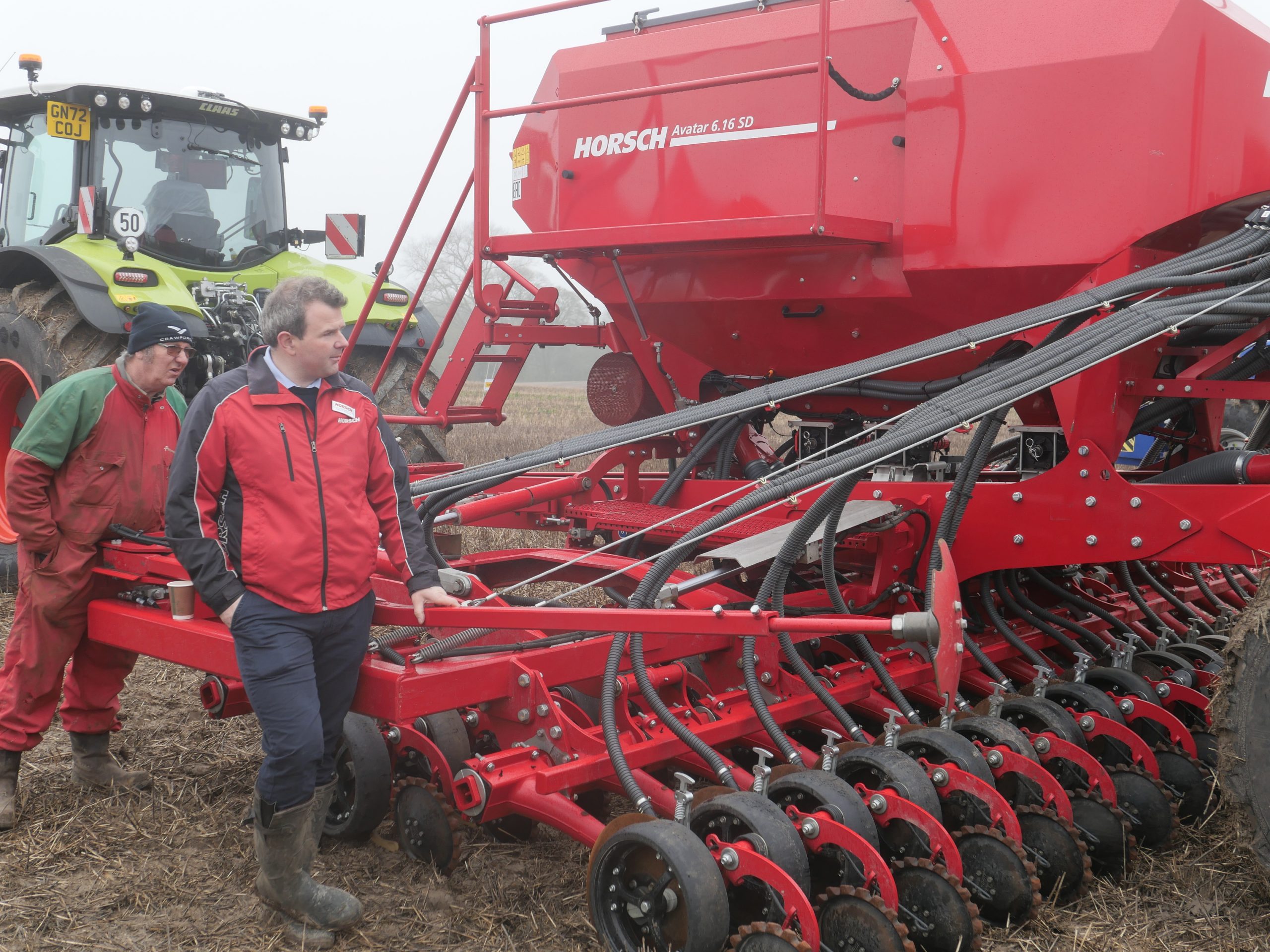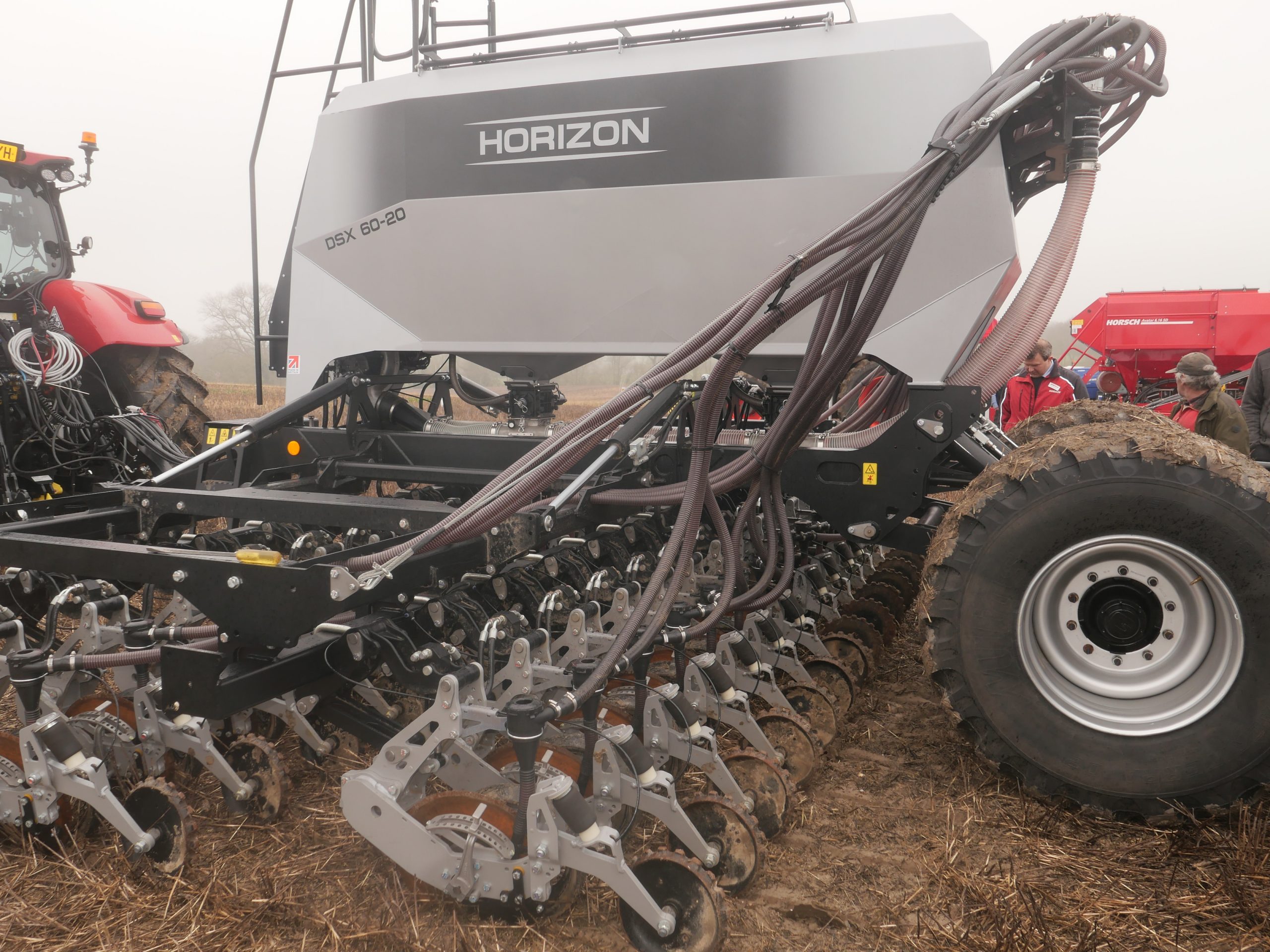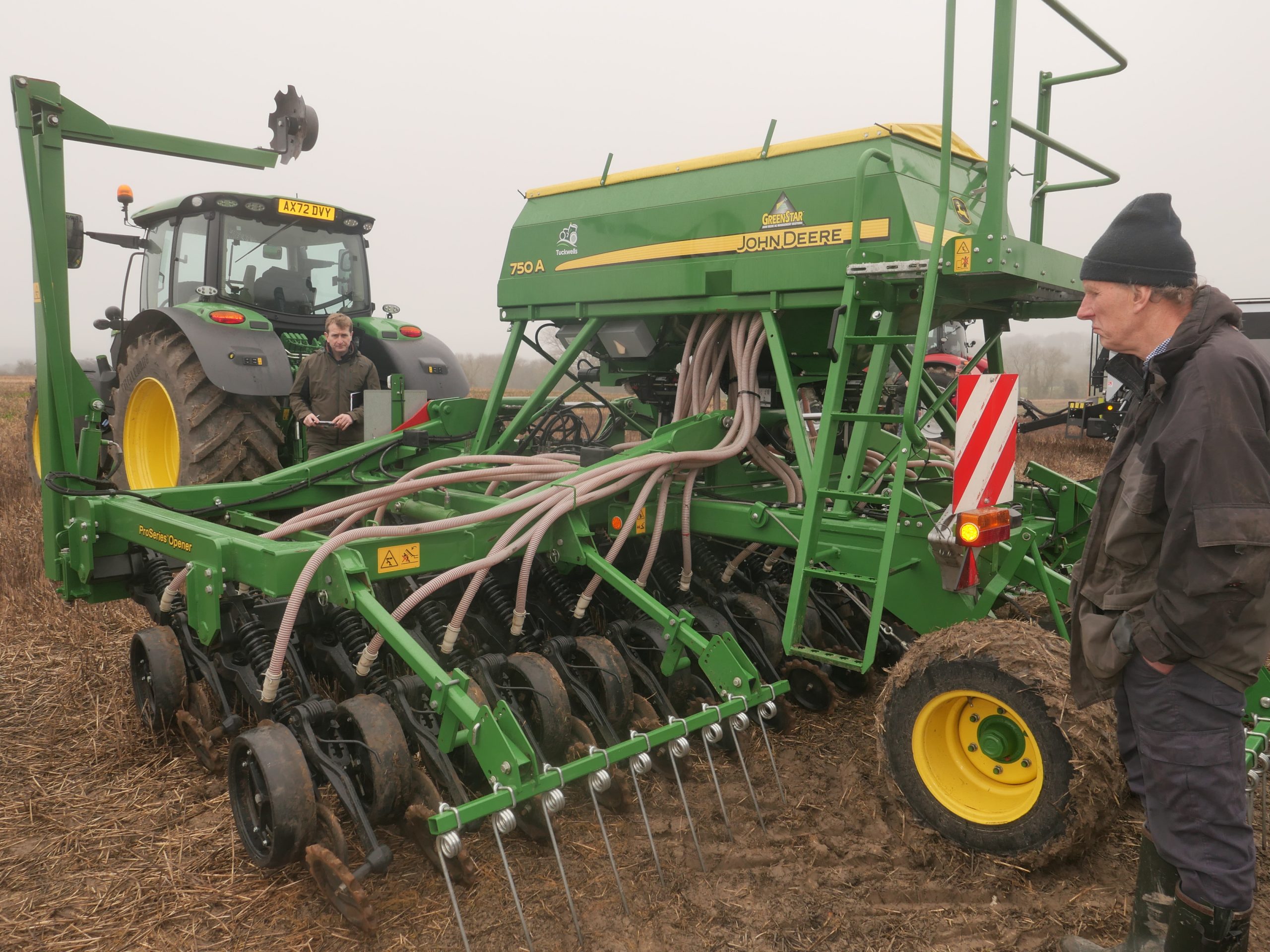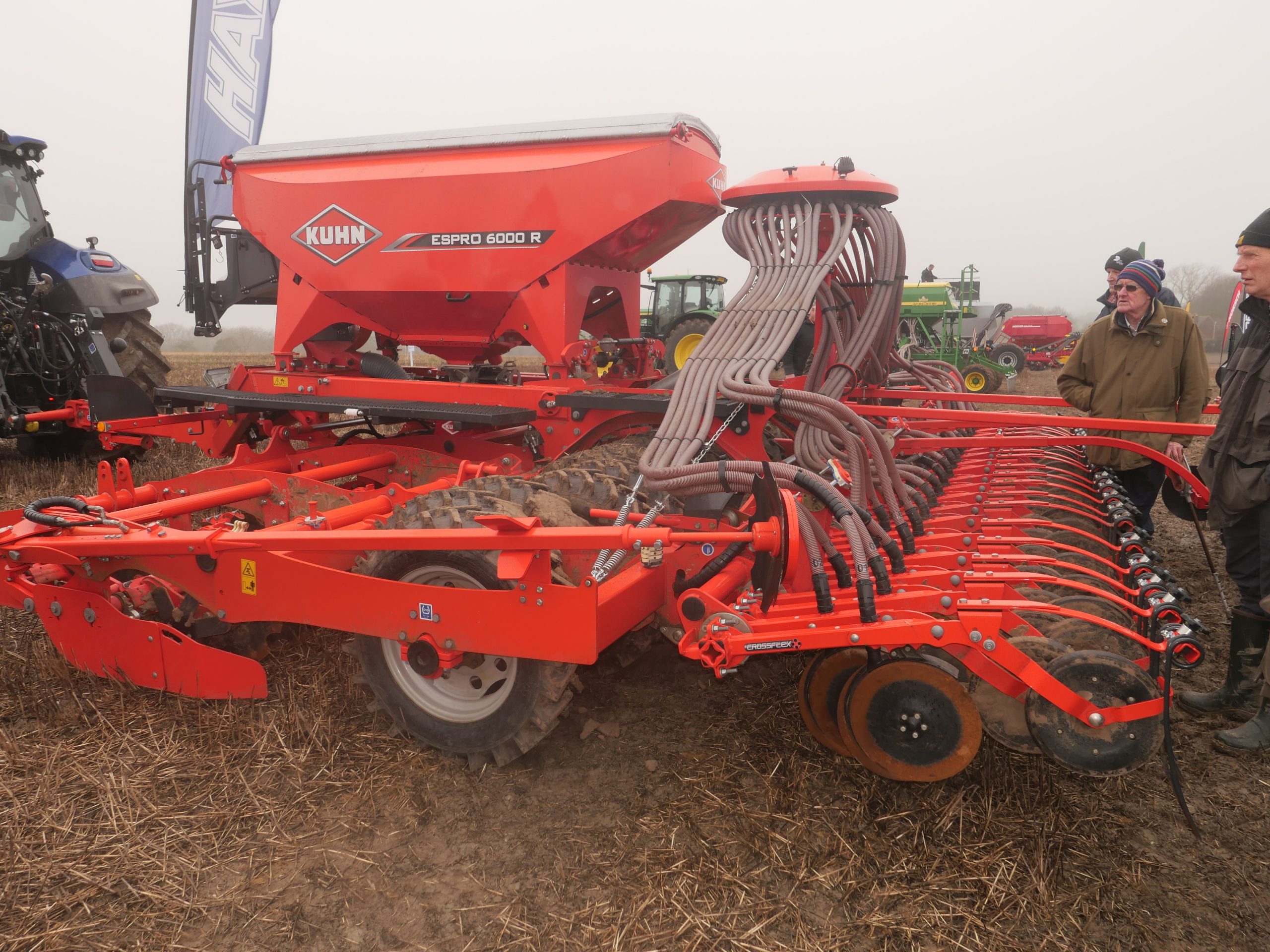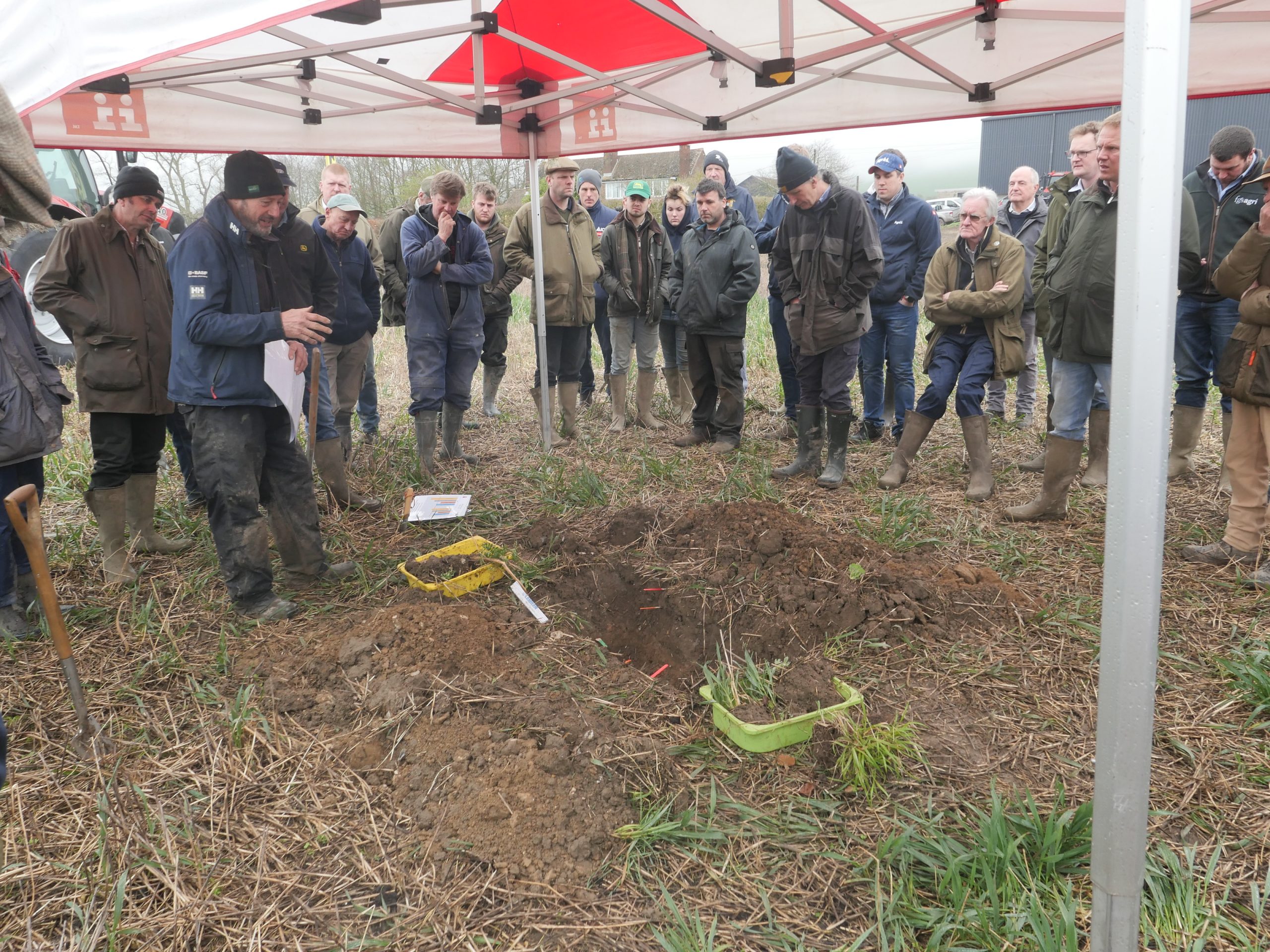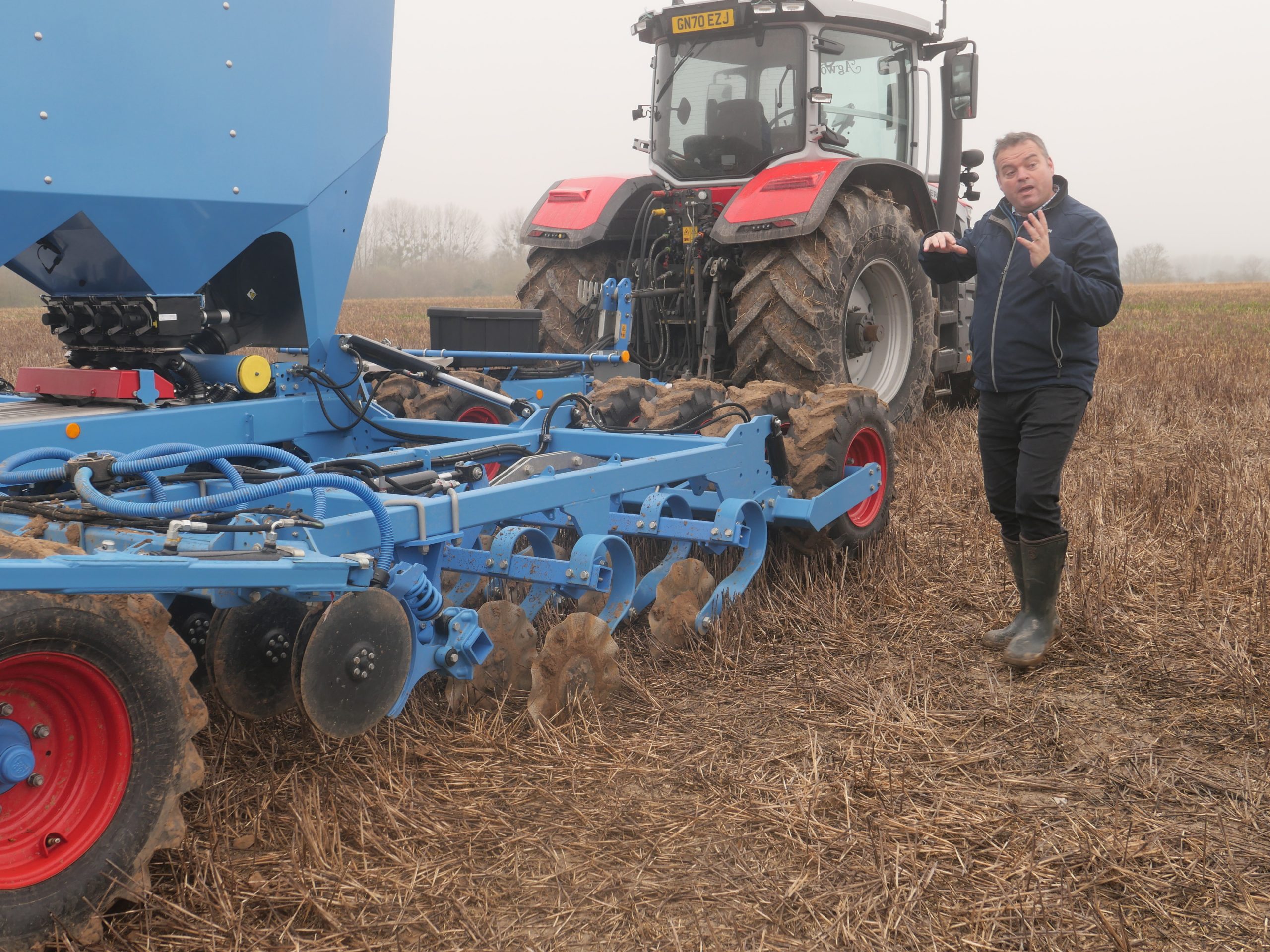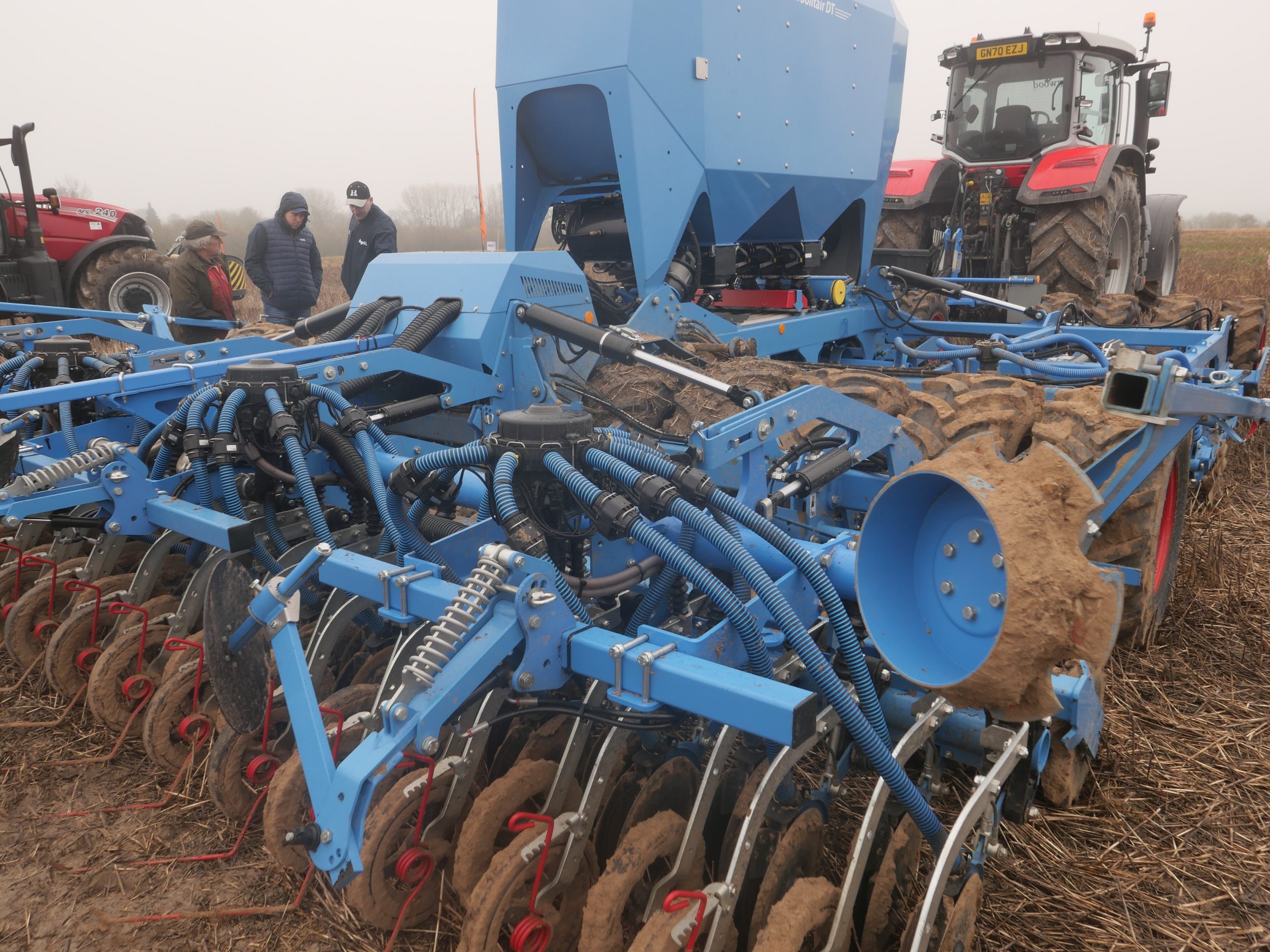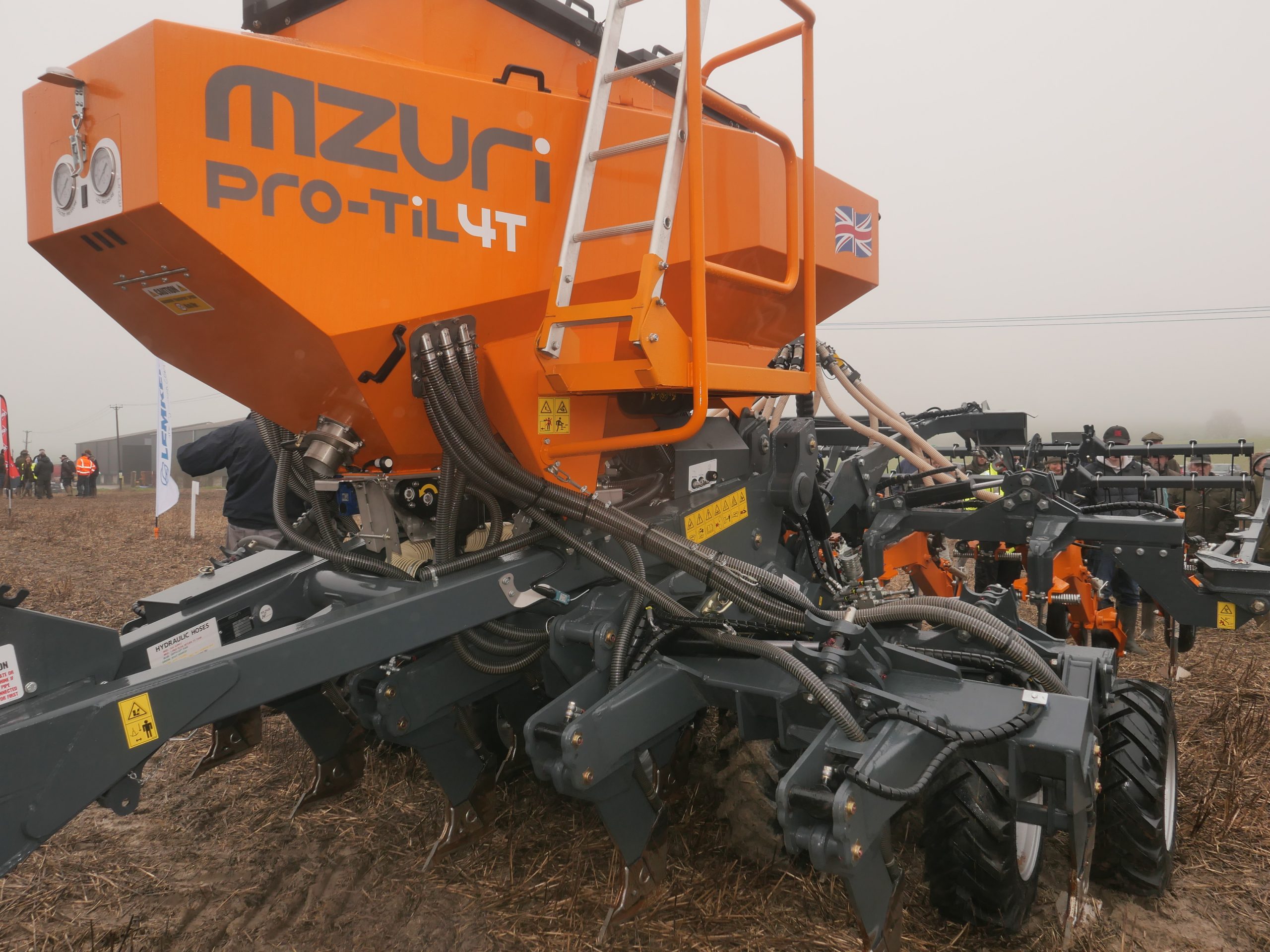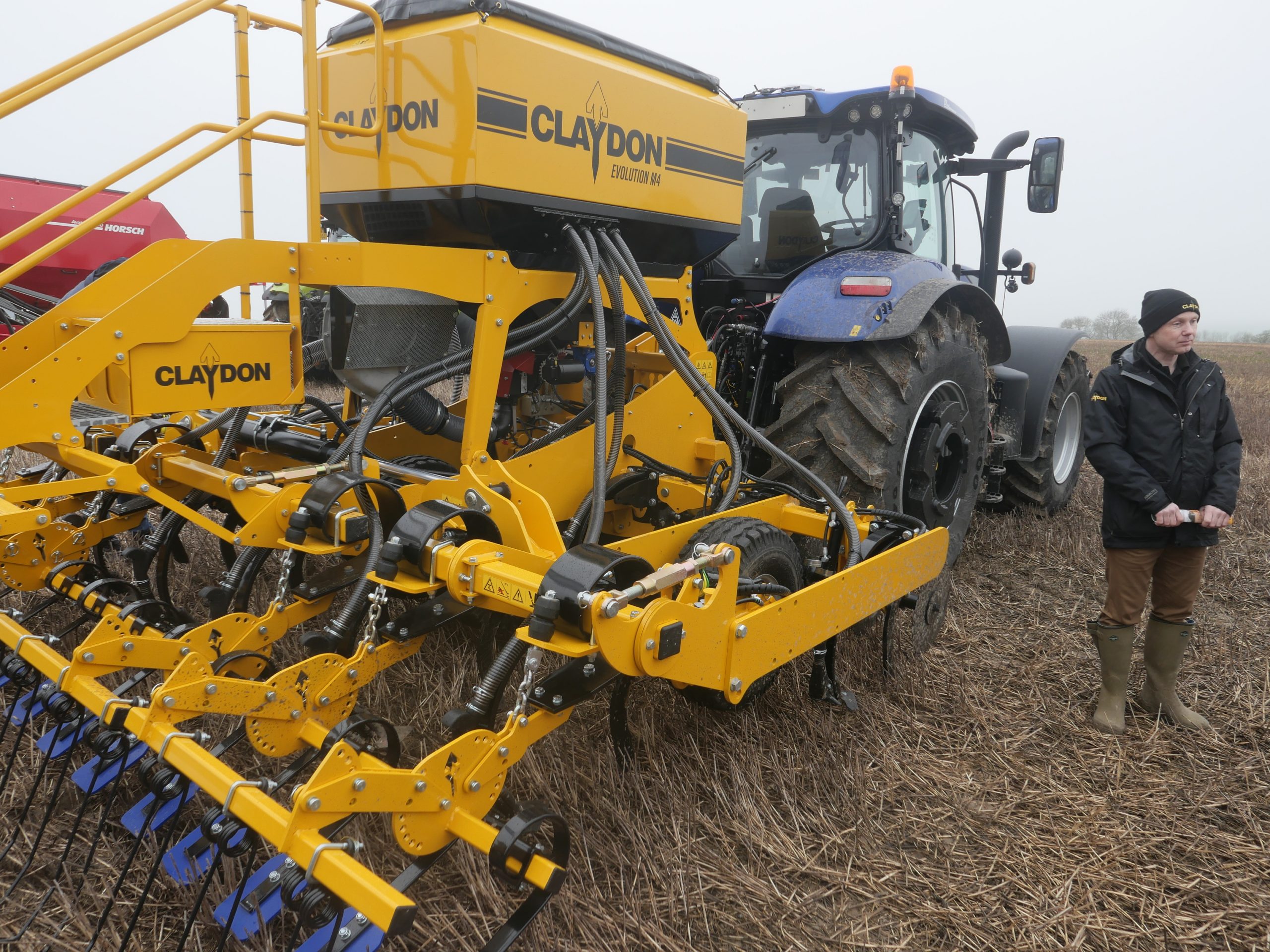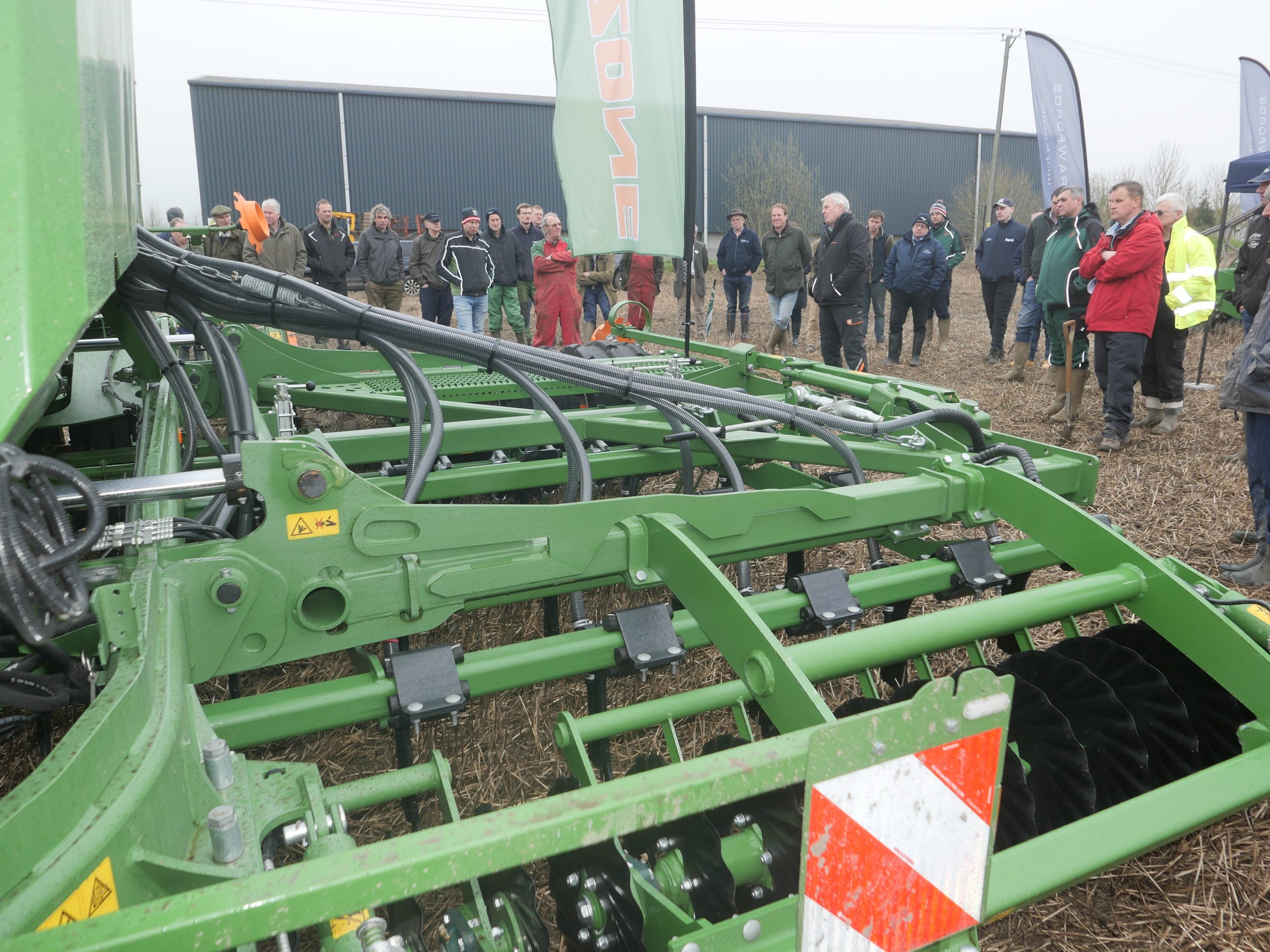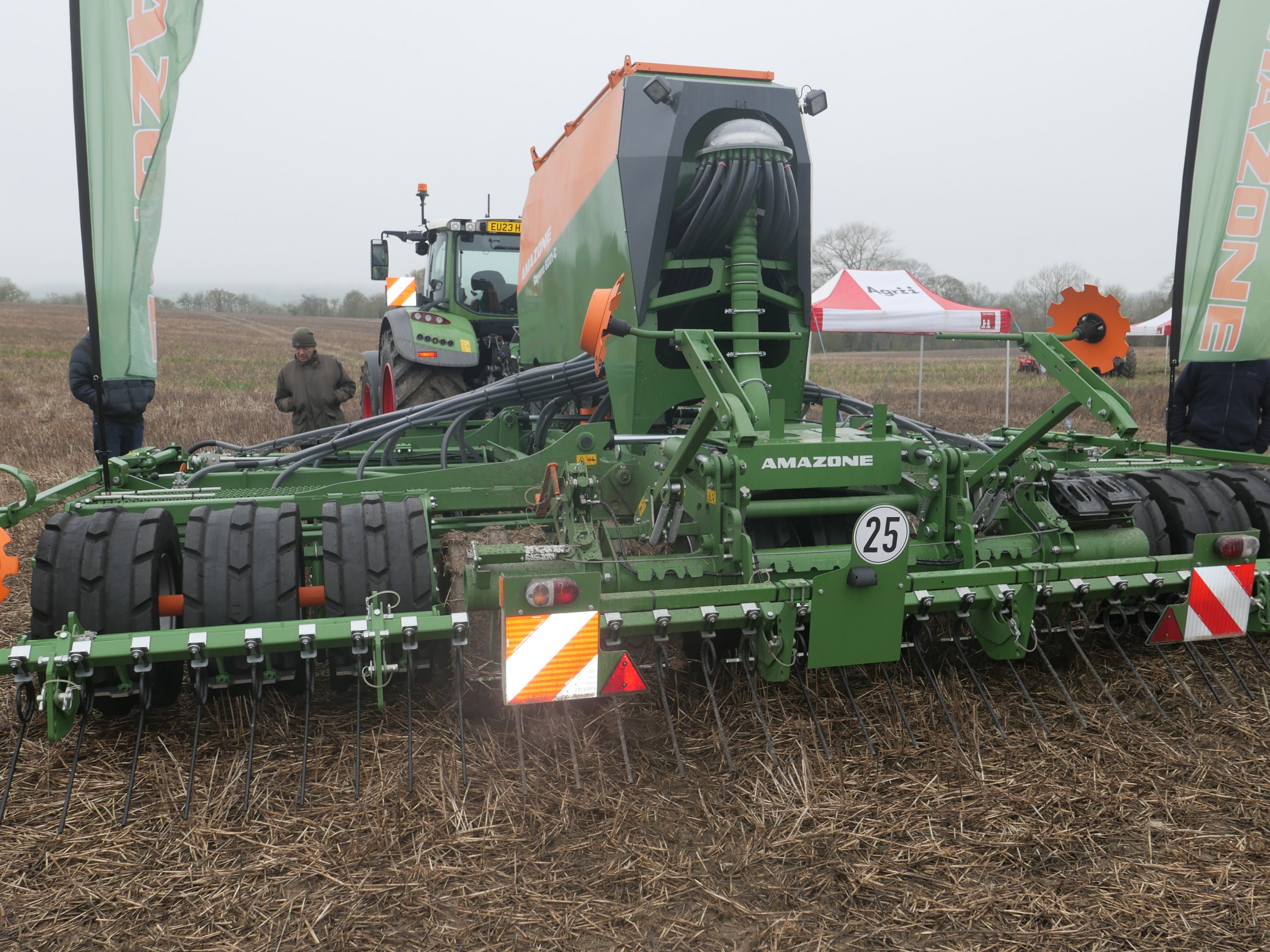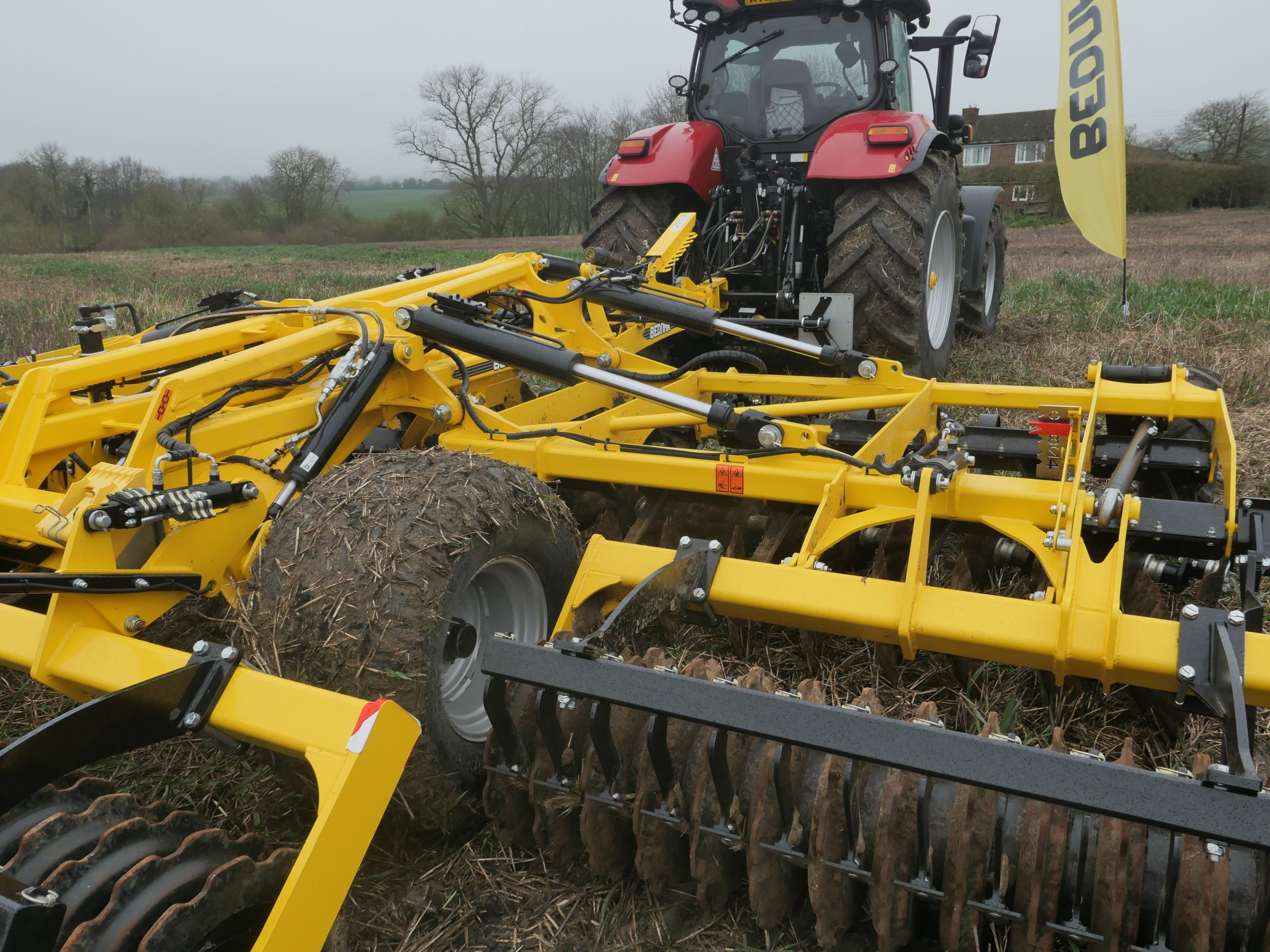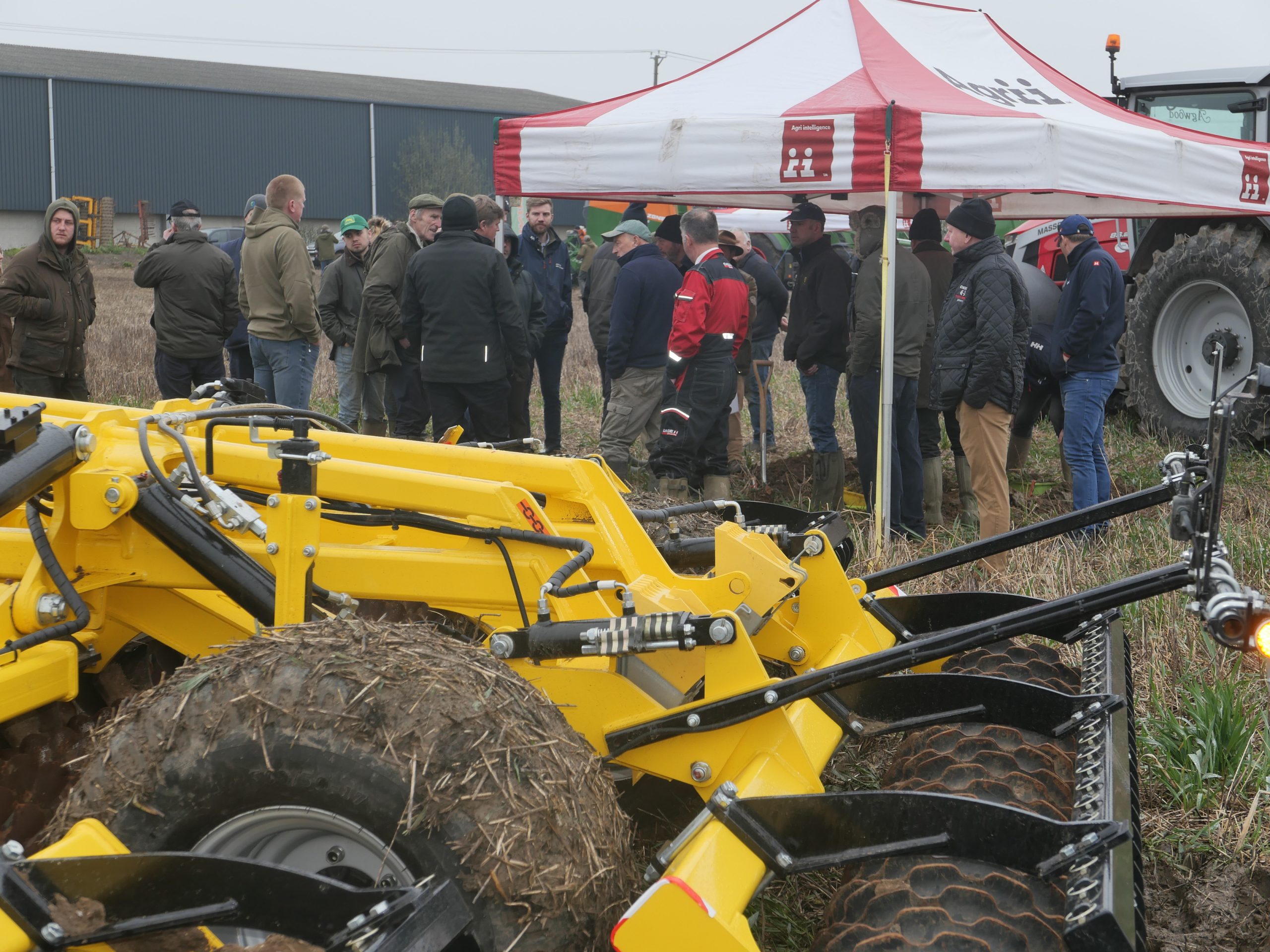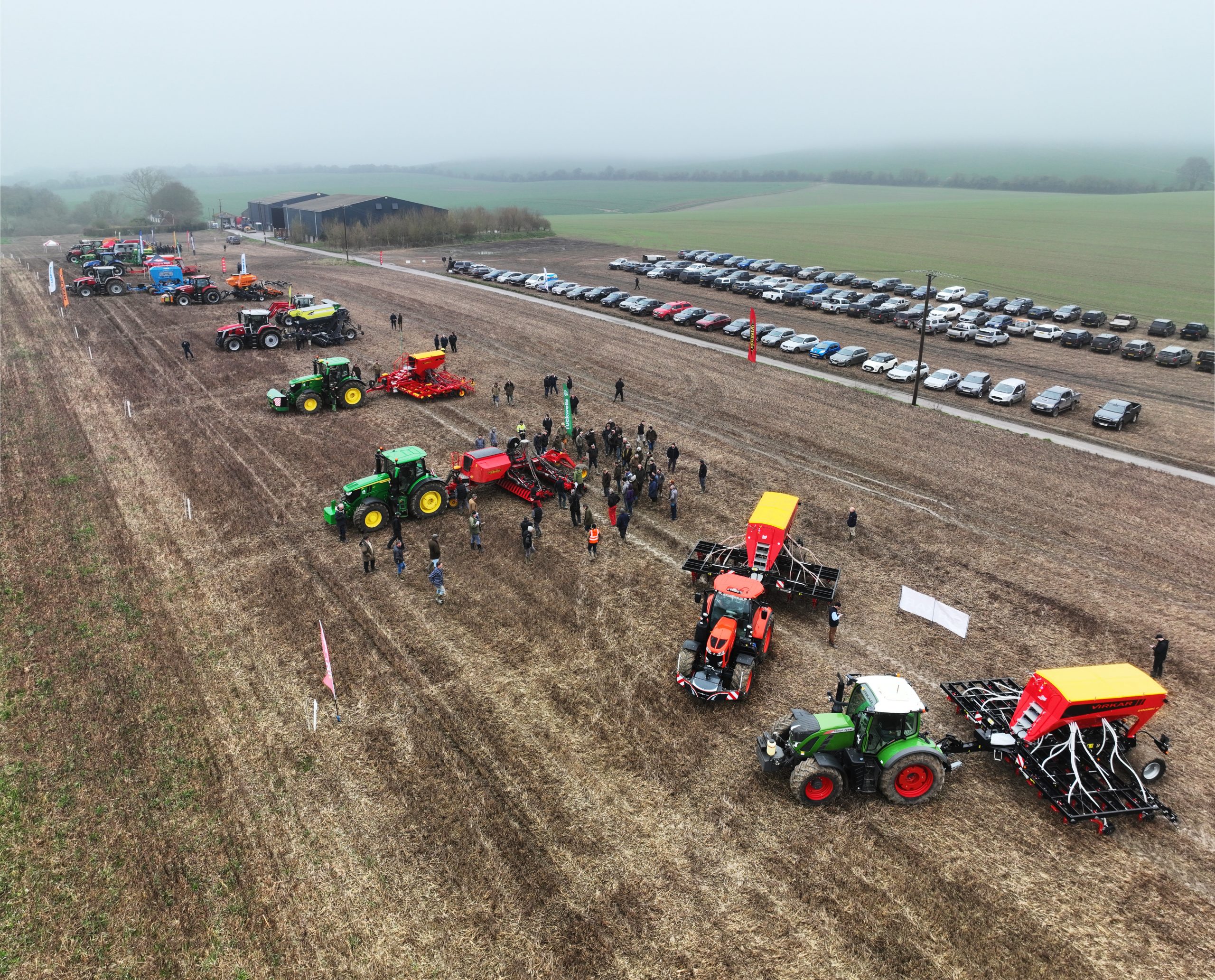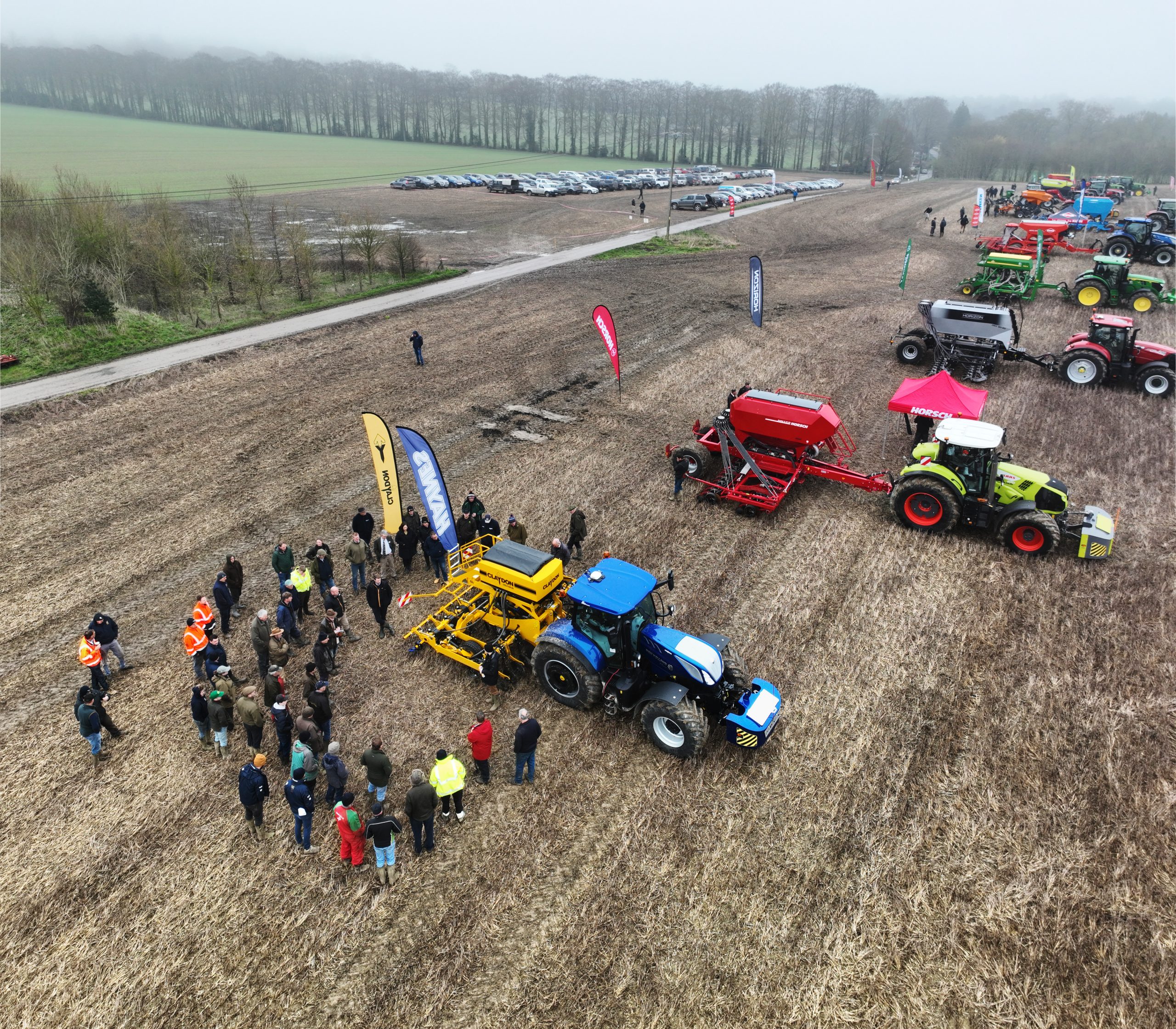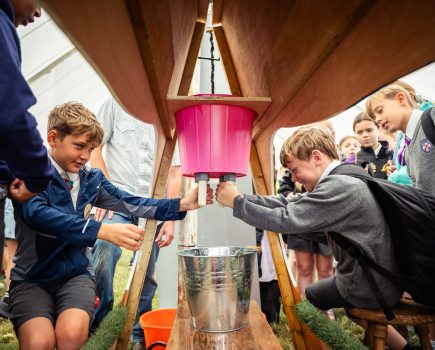The one thing that wasn’t lacking from Agrii’s fascinating drill day event at the end of March was choice. The 220 farmers who flocked from across the South East and East Anglia to look at the machinery on offer were treated to an impressive array of machinery with a remarkable range of capabilities.
The contrast was perhaps best summed up by two machines that were almost alongside each other in the 17-drill line-up at Courtlodge Farm, Harrietsham, just outside Maidstone in Kent.
Proudly standing atop his Aitchison Simtech, George Simon outlined the benefits of his simple yet effective drill with a New Zealand-based pedigree, while two machines along from him, Ludovic Knab was promising to “change the way people drill” with the remarkable pre-production Vaderstad ProSeed.
Between the two, and further highlighting the mind-boggling choice of drills being displayed on a dull and chilly but essentially dry day, was Sky Agriculture’s EasyDrill, a flexible machine suitable for min-till or direct drill applications as well as for drilling into prepared ground.
While the event gave farmers, contractors and the merely interested a chance to get up close and personal to a record-book challenging line up of heavy metal, the event wasn’t exactly what Agrii had in mind.
The original aim had been to put the drills through their paces on the land at Courtlodge Farm, but the wettest March for 40 years made the soil pretty much undrillable, and the plans were rapidly changed.
While Agrii is still hoping to get at least some of the drills back later in the season to pursue the challenge and compare and contrast the results achieved by the various machines, the emphasis of the day itself shifted.
Instead of watching the drills in action, those present enjoyed a detailed in-field presentation and Q&A session with the representatives from a line-up of manufacturers that included Horsch, Lemken, Virkar, Kuhn and Claydon, as well as Amazone, Horizon and Mzuri.
Growers were able to question every aspect of the machines, including whether or not they could be configured to qualify for grants under the Farming Equipment and Technology Fund (FETF) 2023. In most cases the answer was ‘yes’.
“It’s not often that you get so many brands of seed drill in the same field at the same time. To be too-wet-to-go was a great shame,” said Steve Corbett, Agrii trials manager, who helped arrange the day.
Ironically, the soil would have been ideal for drilling had it not been for the rain. Agrii agronomist Neil Harper, who welcomed a large crowd for both morning and afternoon sessions, explained that the site, loaned for the occasion by M C Attwood and Partners, had been planted with a cover crop in August.
“In December it was knee high, but 10 degrees of freezing weather killed it off nicely in the spring,” he commented.
While the weather couldn’t have done a better job getting rid of the cover crop without chemical help, it sadly didn’t play ball for the event itself, although the good news was the manufacturers’ keenness to show off their machinery and support the event. “We had originally planned for six drills but we have 17 to show you,” a delighted Neil commented.
Each session began or ended – depending on which end of the line the visitors started – with a look at the soil structure on the site, courtesy of a trial pit dug and explained by Agrii regional technical adviser David Felce, who stressed the importance of organic matter to glue the structure together and add “good biology”.
The Amazone Cayena 6001-C is, in the words of Crawfords demonstrator Ben Marsh, “a good, all-round machine that can be used for direct drilling and in ploughed soil”.
He went on: “It’s a simple design and easy to adjust, and it holds 60% of the trailed tine drilled market, which proves it’s a tried and tested design that’s earned its popularity with growers.”
The Cayena has front disc and twin tank options and can be fitted with Isobus with section control. With 36 narrow point tines at 16cm spacings, the drill can be towed by as little as 136hp but is flexible enough to drill everything from beans to cover crops, alongside fertiliser from a second hopper.
Crawfords supplies both the Cayena and the flagship Condor 12001-C direct drill across a large part of the South East from dealerships in Ropley in Hampshire, Billingshurst in West Sussex, Charing in Kent and Writtle College in Essex.
The Condor, “an out and out direct drill”, is available in 12 and 15 metre widths but folds down to an impressive three metres for transporting. It has three hoppers for additional seeding flexibility, 25cm row spacings and Isobus control of two, six metre sections. Despite its size it still only needs 240hp to tow at a steady 8kph to 10kph.
After checking out the Amazone offering the group moved on to the Claydon area, where Mike Bywater was demonstrating the impressive Evolution M4 drill, one of an exciting new range that has replaced Claydon’s popular Hybrid series.
Mike highlighted the “simple, user-friendly characteristics” of the drill, together with its low maintenance costs and good ground clearance. The M4 on display was fitted with a front disc option for cutting through a cover crop ahead of seed placement.
With hydraulic depth control, Z harrows at the rear and the ability to match the 4m drill to a 4m hoe, the Claydon mounted drill is ideally suited to direct strip seeding and builds on the manufacturer’s 20 years of experience with the technology.
Nine new models cover working widths of 3m, 4m, 4.5m, 4.8m, 5m and 6m, with hopper size boosted to 1,910 litres for seed-only units and a 2,500-litre tank that can be split 50/50 between seed and fertiliser on the 3MF and MRF models.
The tried and tested front tine followed by 180mm A share is fitted as standard and there is a wide range of seeding share and boot options, while twin tine and disc kit options can be specified for low disturbance drilling.
Sam Downes, from Claydon partner and stockist Haynes, added that the modular nature of the M4 drill increased its flexibility and helped reduce establishment costs and the time taken for drilling. He said both Claydon and Haynes had been keen to demonstrate the popular model and added that he believed it could have coped with the conditions.
Another well-respected drill is Horsch’s Avatar range, and it was a 6.16SD model that was turning heads at the opening day.
Avatar claims its SD (single disc) coulter and seed firmer technology guarantees a safe opening of the furrow and removes harvest residues at the same time, giving optimum contact between seed and soil for quick and safe emergence.
Gareth Burgess said the Avatar was a flexible drill that could be used for direct drilling or on light cultivations and pointed out that it could be fitted with three hoppers, allowing it to, for instance, drill spring barley with a starter fertiliser alongside an application of slug pellets.
While the model on display was a six-metre option, models run from the 3.16SD to the range-topping 8.16SD, all offering high coulter pressure of up to 350kg per row and individually controllable coulter depth.
Gareth praised the “impressive turnout of machines” at the event and said it had provoked a lot of discussion around the different approaches to tilling, particularly on heavier soils in wet conditions.
The Horizon DSX 60-20m, next in the line-up, featured an interesting approach to the problem of ‘seed bounce’ with the final stage of the seed’s journey from the pressurised hopper left to the influence of gravity. Also on display was the John Deere 750A drill, featuring the manufacturer’s ProSeries Opener.
The Espro 6000R from Kuhn is a well-established drill with a heritage that stretches back to the mid-seventies but is well-suited to today’s environment.
The manufacturer highlights the low power requirements of the easy-to-pull, fuel saving Espro thanks to the design of the press wheels preceding the coulter bar. It also offers precision seed placement at speeds of up to 17 kph and an innovative design that keeps soil build up on the packer wheels to a minimum.
Julian Plank showed the drill day devotees around the 6000R, which he said was ideal for min-till situations and boasted low ground pressure, along with a middle set of wheels that could be lifted for negotiating headlands. It also offers full Isobus connectivity and good versatility. “It’s an ideal drill to take you from plough to min-till and, to a certain degree, direct drilling,” he added.
Julian, who hailed the event as a success, said Kuhn was trying to open up “the ploughing window” for farmers as well as helping the move towards direct drill cultivation.
Flexibility is the underlying principle behind Lemken’s Solitair DT, which currently offers working widths of 4m or 6m but with a 9m version on the cards, together with a tank size of 3,400 or 5,100 litres.
The manufacturer describes the Solitair DT as an “incredibly easy to tow, integrated compact disc harrow” which combines comfortable operation with “the greatest possible efficiency and maximum precision”.
Lemken’s Paul Creasey said the flexibility of tool set up at the front of the drill, all adjustable from the cab, together with the split tank (with a third tank option expected at the end of this year) made the drill ideal for those who were moving into companion cropping.
“Every farm has its own system and its own soil type and Lemken has created a drill that is flexible enough to work with any set up, whether that’s intensive, regenerative or low disturbance,” he commented.
The striking bright orange of the Mzuri Pro-Til 4T, a machine bristling with technology, contrasted with the more traditional green of George Simon’s Aitchison Simtech UK T-Sem 300A, a reassuringly simple drill developed by George from a machine built in New Zealand to stitch grass and clover into an existing sward.
George soon realised that the drill would need adapting for UK conditions as the New Zealand sward, tended by millions of sheep, was “tidier” than in this country. The T-Sem 300A is the result, a drill that relies on a pre-slicing disc followed by a shoe that makes an inverted T into which the soil is placed.
“The seed is always going into bare soil, with no trash with it, which gives a good soil to seed contact,” said George, who delivered a comprehensive introduction to his refreshingly straightforward and easy to maintain machine from a platform on the back of it.
The flexibility of Sky’s 6020 EasyDrill HD, which is suitable for all forms of cultivation, extends to its hopper options, with additional attachments front and back giving farmers the possibility of fitting five in total. It also uses a three-point linkage to ensure it follows the contours of the ground efficiently.
Glenn Bootman explained that the option of fitting up to five hoppers was useful when drilling cover crops. “If you drill a mix from a single hopper, by the time you’ve got half way across the field the vibration has sent all the heavier seeds to the bottom, so your mix is no longer a mix,” he said. “Using straights from individual hoppers prevents that happening.”
Glenn said the Sky EasyDrill, distributed in the South East by Agwood, had the versatility to help farmers transition from a conventional establishment method through to min-till or direct drilling, with simple adjustments making it easy to switch from one method to another.
On establishment costs, he said using a disc rather than tines reduced the power needed to pull the drill through the ground. The EasyDrill also benefited from a front press wheel that laid a cover crop in the direction of travel allowing the coulter to pass through easily. He added that the machine had been known to drill through a standing green cover crop “as high as your head”.
While Agwood and Crawfords are responsible for different drill franchises, they both market the He-Va Stealth, described by manufacturer Opico as “a totally new low disturbance subsoiler specifically for the UK market”.
The Stealth is a medium depth, low disturbance subsoiler with scalloped straight front discs designed to cut through trash, vegetation and top soil, reducing soil burst and, in turn, grassweed germination. It has two rows of legs to allow residue to flow through the machine to reduce the required tractor lift capacity and horsepower.
The 15mm hardened cast steel low disturbance points are tungsten tipped and 120mm wide, creating the necessary lift and shatter while ensuring longevity, while surface compaction can be alleviated to a maximum working depth of 300mm (12”). The Stealth is aimed at supporting no-till and reduced input systems but can also be used on headlands, tramlines or other high traffic areas.
Vaderstad’s Rapid A 600S is a well-established drill that has continued to improve over time and is another machine that is capable of following the trend towards direct drilling and is designed to allow accurate placement of seeds at speed for even germination.
The seed fan is now housed inside the hopper to keep it out of the dust, while reinforced tyres are now fitted to shrug off flints. Vaderstad’s SeedEye technology enables seed rates to be calculated on a seeds/sq m basis.
It was the second Vaderstad in the line-up that really caught the eye, though. Introduced by Ludovic Knab, the pre-production ProSeed is currently being trialled at a number of sites but is not due to be launched until the end of the year and should be available next year.
The ProSeed coulter brings precision metering to all seeds, with rates adjustable from 50 to 400 seeds/sq m while the new design closes the soil around the seed instead of pressing the seed into it. Ludovic explained that the ProSeed could handle every crop, from sugar beet and cereals to peas and even pumpkins, and would reduce costs by ensuring the same germination rate from fewer seeds.
Virkar’s Dynamic DC drill is a disc and coulter machine with twin hoppers that are split longitudinally to spread the weight of the machine more evenly and help it track across sloping ground.
Nigel Long explained that the Virkar’s wavy turbo discs cleared trash from the path of the drill before placing the seed in a cultivated seed bed, giving good seed to soil connection. The Dynamic C drill is a coulter only version, with both Dynamic DC and Dynamic C formats available in 6m width with 19cm or 25cm row spacing.
With high body clearance and a low horsepower requirement due to their light weight, the Virkars also benefit from a steering rear axle that makes them highly manoeuvrable and aids coulter spacing on corners.
At the end of a fascinating line up of drills presented by knowledgeable and enthusiastic manufacturers was the Weaving GD, a disc drill designed for sowing directly into non-cultivated soils or cover crops and available as a mounted or trailed design.
- Kent drill demo day (©Andrew Watts/Agrii)
- Kent drill demo day (©Andrew Watts/Agrii)
- Kent drill demo day (©Andrew Watts/Agrii)
For more like this, sign up for the FREE South East Farmer e-newsletter here and receive all the latest farming news, reviews and insight straight to your inbox.

